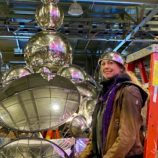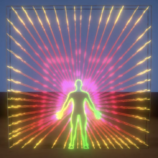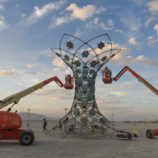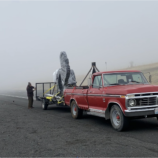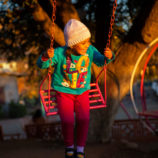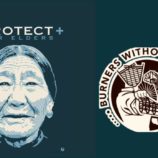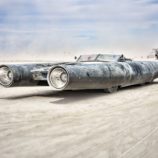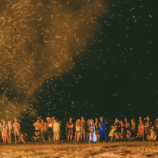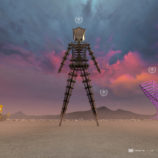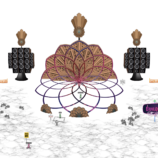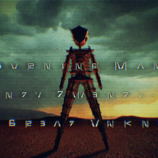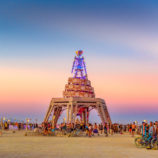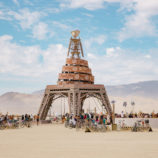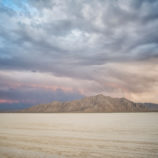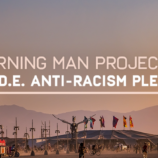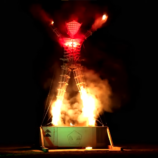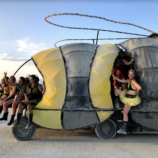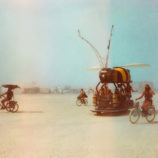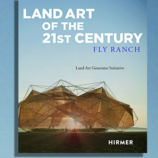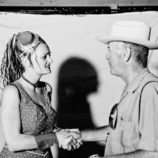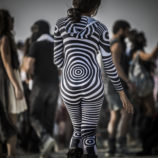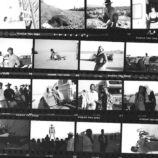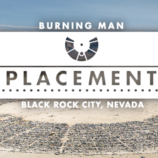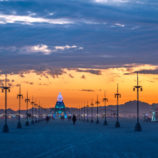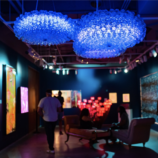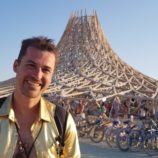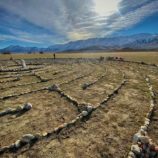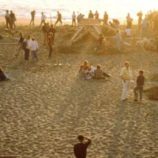The AfterBurn is our annual look back at the past year in Burning Man history — its ups, its downs, and its get-back-up-agains. Burning Man Project, the official name of the nonprofit Burning Man organization, is operated and supported by thousands of people who take responsibility for making Burning Man happen in the Black Rock Desert and around the world. The AfterBurn Report highlights what our various departments do, why they do it, what changes occur year to year, our successes and failures, and our vision for the future. Browse past years’ AfterBurns here. (We also annually publish the Dispatch about our overall vision, impact, and health as a nonprofit, including a snapshot of our finances.)
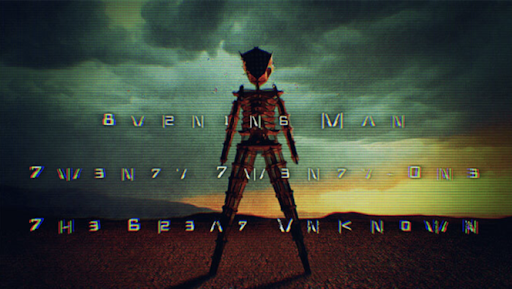
Burning Man 2021: The Great Unknown
Illuminating The Great Unknown
Before we dive into the joyful act of rebuilding and celebration, it’s important to understand how the heck we all got here. The impulse, perhaps, is to imagine all the things to come as we emerge and plan Waking Dreams. But to jump ahead without acknowledging our collective experience is like skipping the part of the story where all that juicy character development happens.
We do this by sharing our stories. As a global community, this is how we learn.
Welcome to the 2021 AfterBurn — the retelling of our year, as experienced by many of Burning Man Project’s teams and departments. It shares learnings, and lessons — applicable to anyone interested in creating community-led experiences in the global Burning Man community and beyond.
This year, without our city in the desert and so many other key Regional Events, we saw the culture burst forth, propagate, and morph in so many unanticipated but perfect ways.
In 2021 Burning Man was everywhere. As always, but even more so during a year without Black Rock City, it was our mission to support the myriad expressions of the culture that emerged as a result.
You built Art No Matter What. We supported artists to create works of art that rose in multiple cities around the world.
Burners gathered in oh so many ways. You came together to build and explore wildly inventive virtual experiences. As a global community, we safely hosted oh-so-many community gatherings closer to home, including a handful of Regional Events.
You advanced important community projects. We advanced our internal and community work around Radical Inclusion, Diversity, & Equity. Working with the community, we ideated and prototyped ways to make our desert city radically more sustainable, and did much-needed work on our Northern Nevada properties. Burners learned together, built community, and hatched new projects in Burning Man Hive.
We shared stories and cultural conversations. Together we hosted Global Activation calls, an ArtSpeaks series, held convenings, and ran campouts at Fly Ranch. We shared stories on the Burning Man LIVE podcast, and even published a book.
And, of course, we burned the Man.
Read on to discover all of these stories, and a multitude of other ways the dedicated teams at Burning Man Project facilitated and extended Burning Man culture in 2021.
Table of Contents
For complete descriptions of the various Black Rock City teams, visit the Volunteer teams page.
1. Art & Civic Activation
Burning Man Arts
Katie Hazard writes:
In another year without BRC — sans dusty hugs, without the art we all love so much making its long way home to the desert — it was more important than ever for our Art team to support and encourage Art No Matter What from our entire global Burning Man community. We shared and celebrated local art, diverse global artists, community events, and virtual offerings, as well as past and present Honoraria who continued to dream and create amidst the pandemic — building, installing, or exhibiting their art in 2021 with radical perseverance.
This year, one of the things our team was most proud of was offering virtual events honoring artists and the art community withour artist storytelling series Art Speaks, and Desert Arts Preview, as well as a presentation of the 2021 virtual temple. Talk about kicking ass as collaborators, we were thrilled to offer the community a virtual temple, permanent installations at Google’s Charleston East Plaza, a virtual Man Burn, Sotheby’s Boundless Space auction, art content on our Burning Man Hive learning platform, fundraising presentations, ARTerian Book Club, volunteer engagement, and more — all while our team only had one full-time employee. (Phew!)
While 2021 was a unique year in many ways, our Art team continued to carry forward many of the adaptations we already made in 2020. We supported projects that kept art alive for the community, no matter what!
BURNING MAN ARTS BY THE NUMBERS
- Honoraria carried forward from 2020: 62
- Grants awarded to Honoraria artists: $952,247
- Virtual Ethereal Empyrean Temple
- 2 webinars in advance, featuring interviews with the Temple artists
- Total audience of webinars: 3,762 participants
- 3,141 Offerings were made in the digital platform
- Offerings were viewed 40,485 times during the course of Burn Week
ArtSpeaks:
- Created three episodes in 2021 (including the Virtual Temple)
- Total reach/audience: 4,345 views
- Participating Artists: 9
LOOKING AHEAD TO 2022
The Burning Man Project Art Department would love to get back to supporting and creating in-person events featuring even more physical art! We’re looking forward to being fully staffed, and continuing to focus on Radical Inclusion, Diversity, and Equity (R.I.D.E.) and Sustainability (i.e: how we handle wood if it doesn’t get burned, and analyzing what we burn rather than how much). Our team plans to accommodate years of Honoraria artists and projects, as many of them make their trek to the desert. Dedicated volunteers will once again build a virtual temple,
for greater global access to the event and art of BRC.
LEARN MORE
- Virtual Ethereal Empyrean Experience: Temple 2021
- Flame Effects for the Artist workshop (led by Dave X in Wisconsin — September 2021)
- 2021: The Year of “Art No Matter What”
IN THE JOURNAL:
Burners Without Borders
Molly Rose writes:
Burners Without Borders (BWB) was created in response to Hurricane Katrina, a 2005 crisis. Although we were built on a traditional “disaster response paradigm,” for several years now we were seeing that the world was changing; the old ways of organizing needed to evolve.
As COVID-19 spread across the world, suddenly BWB’s work was front and center. Our essay, “The Long Disaster,” described our new everyday reality. No longer was the disaster rooted in a certain place for a certain amount of time — it was everywhere, affecting everyone, and was going to stretch out for what would feel like indefinitely.
BWB didn’t pivot; instead we emerged into our own moment. It felt as though BWB had been building towards this very time in history. The work BWB has done around community resiliency, mutual aid, activated citizenship and more were the very skills needed in 2020. BWB still needed to adapt the toolsets to work in these new circumstances. Out of this new framework, new collaborations emerged.
This year, our team created a BWB Chapter Binder and updated our Chapter Agreement, which improved processes for both chapter groups and projects to be supported by BWB.
With the United States Institute of Peace (USIP) we co-produced the Culturally Attuned podcast and Cultural Synergy Online Course . We also held a “Working With Civic Institutions” Community Call.
PEDACITO DE LA TIERRA
In February 2021, we co-produced and released both the Pedacito de la Tierra film and live event (with Alight). This project captured the imagination of many nationwide, and continues to receive accolades.
We worked together with Burner volunteers to document the space transformation of immigrant shelter in Nogales, Mexico. Collaboratively, we built a cobb oven (horno), and amplified the stories of resilience from residents on their immigration journey as well as local nuns, who dedicate their lives to serving the local families and communities.
BWB partnered with Civic Ignition Winner to expand Recipes for Resilience (a BWB grant recipient). We innovated and hosted an immersive, dual-lingual community dinner which demonstrated to donors and supporters that they could feel deeply connected to a project without an in-person donor visit. From this prototype of a hybrid (both virtual and in-person) event, we created a toolkit to share with other civic impact projects.
ADJUSTING TO THE ONGOING PANDEMIC
This past spring, we produced Burning Man Project’s first external-facing in-person event since the start of pandemic (BWB Spring Summit). We introduced and prototyped COVID-19 safety measures which were implemented subsequently at Burning Man Project’s Gerlach and Fly Ranch events. We also used remote time to work on administrative systems and process overhauls, utilizing the skills and support of Associate Director Emma Weisman.
BWB BY THE NUMBERS
- BWB Hosted 99 participants at Fly Ranch for the BWB Spring Summit 2021
- Engaged 110 participants at the Civic Activation: Working with Civic Institutions community call
- Received 13 project proposals from new project leads
- The film Pedacito de la Tierra received three awards at film festivals and was shown at the Venice Biennale
- Registered 1,381 participants for Pedacito de la Tierra — with over 400 participants in the room at once, and 13.3k viewers on the live stream
LOOKING AHEAD TO 2022
Looking forward, we are trying to understand our resources so that we can right-size our programming. We plan to collaborate inter-departmentally to meet multiple programming objectives through shared work with the Civic Activation department, and plan to continue to integrate an anti-racism lens throughout our programming and with our community.
LEARN MORE
- Portland collaboration on infrastructure for three homeless villages
- BWB-BRC Speaker Series 2020: The Long Disaster (with Nick Farr and Lia Holland)
- Pedacito de la Tierra feature article
- Food and Wine Magazine article on Pedacito de la Tierra
- Co-creating the New World Podcast (with Nick Farr and Dawn Strickland, BWB)
- Fire and Water: Mutual Aid in the Aftermath of the Texas Freeze
- Culturally Attuned podcast
- SuperNice Club Podcast (with Molly Rose, BWB)
- Cultural Synergy Course
- Pedacito de la Tierra event
- Working With Civic Institutions call
IN THE JOURNAL:
Community Events
Steven Raspa writes:
In 2021, our team supported the Boundless Space exhibit and auction with community driven programming, talks, meet-ups, and wildly fun experiences that turned the gallery space in Sotheby’s NYC headquarters into a forum for shared experience, deep conversations about the role of art in society, R.I.D.E. (Radical Inclusion, Diversity, and Equity), and interviews with artists and cultural changemakers in NYC.
Burning Man Project’s Executive Producer Justin Katz worked with the Fly Ranch team to support multiple events at Fly Ranch this summer, including the BWB Spring Summit, the kickoff of the LAGI Campout, and a Philanthropic Engagement weekend campout. He also consulted with The 360 team to support the design and rollout of the pilot weekend experiences. These events also helped advance thinking about event templates for those new forums.
In September, $teven Ra$pa attended the 42nd annual Ars Electronica festival for art, technology, and society, with financial support from the Public Affairs office of the US Embassy in Austria. The theme was “A New Digital Deal” and Ra$pa spoke on a panel to share lessons related to bringing culture and community online. He participated in a panel discussion on the subject of “Digital Humanism”. While there, Ra$pa attended Burner meetups in Linz and Vienna, and met with Ars Electronica event organizers to discuss how we can support artists and share learnings.
While in Austria, Ra$pa also met with local Burning Man Regional Contacts, and celebrated the unveiling of Burning Man Honorarium art project Schrödinger’s Rat, which made its debut at Ars Electronica 2021 and is bound for Black Rock City in 2022. Ra$pa met with members of the U.S. Embassy and Open Austria for conversations about art as a means of cultural ambassadorship in the world. It was additionally a fantastic opportunity for Ra$pa to connect with amazing artists from Austria and throughout the world, and with the organizers of the official Burning Man Regional Event Schloss Schönburn. Burning Man Project was recognized as a humanist organization, playing an important role in cultural exchange and ambassadorship through art.
Much energy was spent managing free public programming and community events related to the Sotheby’s exhibition and auction, and engaging with a partner in a way that successfully pushed cultural boundaries. We poured a lot of energy into making the Sotheby’s exhibition and auction a successful forum for our global community to regather, socialize, and self reflect. It was so much more than just a fundraising endeavor.
Our team also supported Burn Week: Global Live Stream in order to help it grow from a 24-hour event in 2020 to a full week of global community engagement in 2021. We also designed and produced the first two “Return to BRC 2022” events that engaged with a wide circle of our leadership to help get us aligned in our return to Black Rock City. Our Community Events team helped support the successful rollout of the 365 Guide, which encouraged our community to discover all the ways it’s possible to burn year-round!
In order to pivot to adjust to the ongoing pandemic in 2021, our team continued to support online programming, which connected our community as COVID-19 continued to limit in-person events.
After months of virtual meetings and events, the screen fatigue was palpable — one big challenge we faced was honoring that many members of our community and even of our own team deeply missed in-person events and were not as excited about online or virtual events. It often felt overwhelming, the amount of time we were all spending online, staring at screens. We understandably witnessed a handful of individuals stepping away for a while, pausing to breathe, until live events are able to safely happen again.
COMMUNITY EVENTS BY THE NUMBERS
In 2021 our virtual events reached thousands of households, ranging from 100-500 per individual event. Most of our team supported other teams this year to build capacity and continue online programming to reach new global audiences with online events and programs. This year was mostly about building on accessibility to the culture, thinking about refinements to in-person events in coming years, and trying to stay sane.
Members of our team also stayed in communication with Burning Man’s 108 official Regional Event teams and many unofficial ones to offer support, compare notes, and be mutually supportive. (Read more about Regional Events in the Regional Network section below.)
- Boundless Space: We supported 180 artists from 22 countries over six days at the exhibition and charitable auction at Sotheby’s NYC, with over 30 different activations and performances
- Brought together over 350 active community leaders, artists, camp organizers, and volunteers in our first-ever “Core Cultural Collaborators” online event
- Burn Week: Global Live Stream had 17,691 participants from 144 counties; 24,433 total sessions and 74,422 page views
LOOKING AHEAD TO 2022
For 2022 we plan to continue to host and encourage 10 Principled online and hybrid events while beginning to bring back in-person events in the Bay Area. We plan to support in-person Regional Events globally and assist with bringing back our beloved Black Rock City! We’re thinking about how to keep the inclusivity of global online gatherings and bring back the in-person events we love. We are looking at a lighter year of in-person events in the Bay Area to focus resources and energy on bringing back Black Rock City and supporting the return of in-person Regional Events around the world.
We hope to continue to increase the skill level and engagement of Community Events team members and we will continue to prioritize sharing health and safety best practices for online and in-person gatherings. Our team will also share and promote learning throughout the global community.
LEARN MORE
- 365: A Burning Man Field Guide
- Pedacito de la Tierra event
- The 10 Principles in Modern Times: A deep-dive with Ra$pa, Stuart Mangrum, and Athena Demos (edited from the BRCvr experience)
- A Love Letter to Small Events
- Ars Electronica 2021 Festival for Art, Technology & Society
- Ecosystem Activation
- 2021 Camp Symposium
- Stadt Nach 8: One of Ra$pa’s three in-person appearances as a speaker for conferences in Berlin, Germany
- Schrödinger’s Rat
IN THE JOURNAL:
Regional Network
Iris Yee writes:
The global pandemic continued to impact the communities, events, and activities of the Regional Network in 2021. Shifting local governmental regulations about COVID-19 safety practices varied throughout the year: keeping some Regional communities physically apart, others able to gather in small groups, and only allowing a handful to return to larger Regional Events. Some began planning their regular Regional Events only to have to cancel them or move them online (again). Other communities enjoyed development of close knit connections through small, intimate gatherings. We’re all still just finding our way through this pandemic and back together.
Whether trying to emerge from pandemic-related isolation, sheltering and healing, or adapting and thriving in a changed world despite the persistence of COVID-19, the Regional Network Committee knew that we needed to bring Regional Contacts and Regional Event leaders together, meeting them wherever they and their communities might be in their journey.
REGIONAL NETWORK FORUM
On June 5th, the Regional Network Committee community welcomed Regional Contacts, official Regional Event producers, and community leaders across the global Burning Man community to a virtual Burning Man Regional Network Forum about emerging, wayfinding, igniting — inviting attendees to reconnect with peers, and reignite inspiration in Burning Man culture beyond Black Rock City through discussions of how our local gatherings, spaces, and projects can be more inclusive, environmentally sustainable, and meaningfully connected.
Regional Network Forum content was curated to address priority topics revealed through 2020 Annual Regional Recap Reports and Q1 and Q2 check-in conversations with Regional Contacts. Program highlights included:
- What it means to be a Burner in 2021 with community leaders sharing a diverse range of experiences and perspectives
- Cultural mutation and scaling Burning Man culture in healthy ways with perspectives shared by co-creators of the The Borderland in Scandinavia and Burner Embassy Berlin
- What Radical Inclusion, Diversity, and Equity (R.I.D.E.) looks like in different regional communities including AfrikaBurn in South Africa
- Practical steps Burners can take to improve the accessibility of their events, camps, and community spaces from representatives of Burning Wish, Mobility Camp, Blind Burners and Element 11 in Utah
- Learnings from some of the earliest Regional groups to hold in-person events during a global pandemic including Kiwiburn in New Zealand and Turtle Burn in Taiwan
- Spotlights on projects moving Burning Man culture forward in daily pandemic life from resilient Regional groups in the United States and Japan
- Features on how some Regional groups, including Burning Seed’s Red Earth Ecology in Australia, are prototyping greener, regenerative solutions at their events
ADJUSTING TO THE ONGOING PANDEMIC
Burners have continued to foster community and have found creative ways to connect through small and informal gatherings such as picnics, hikes, backyard get togethers, and campouts.
- In Singapore, Burners donned costumes and decorated their bicycles for small group art rides to enjoy civic light festivals and art installations spread throughout their city, much like they would do in Black Rock City.
- In Sweden, Burners met up in small groups on boats in a gathering they dubbed Boaterland.
- In Toronto, a Burner drove the mutant vehicle, SteamPunkin, around the city to create socially-distanced pop-up parties.
- In Virginia, Burners turned their indoor meet-up into a monthly sunrise meet-up on the beach for coffee. They burned a COVID-19 effigy together on the Summer Solstice.
For a second year, we saw emotions intensify as a result of division in various communities regarding vaccines, masks, and other safety requirements, and whether to hold events or not. There was and remains some polarization. Varying degrees of vaccine access and closed borders also made it difficult to plan and gather for many Regions. Volunteer retention, recruitment, and healthy leadership succession were especially difficult this year, as fatigue set in related to COVID-19 uncertainty and financial pressures.
Energy that would have normally gone into producing Regional events allowed some teams to focus on other forms of community engagement, such as emotional support, building out community spaces, and public service projects in direct response to COVID-19.
On the bright side, smaller, dispersed, local events cropped up in place of large multinational events. The culture spilled over more into everyday life, with local versions of what you normally find at official events (like front porch theme camps, drive-through experiences, neighborhood parades, art grants, and interactive art on front lawns). They were easier and safer to do, and we love how small events helped build, diversify, and renew our community over the past year!
REGIONAL NETWORK BY THE NUMBERS
- The Regional Network is composed of 250 volunteer Regional Contacts in 115 regions in 32 countries
- The Regional Network program is supported by two full-time and two part-time employees
- 29 Regional Contacts retired from their RC role in 2021
- 14 new Regional Contacts were welcomed to the Regional Network
- The Regional Network Committee met with 232 RCs from 115 regions during 2021
- Official Regional Events doubled from 20 (in 2020) to 40 (in 2021). We expect to see a steady climb in the next 19 months toward the levels of 108 official Regional Events that were held in 2019
- There were 30 in-person official Regional Events that met or exceeded local safety requirements — ranging from screening on site, to testing and vaccination requirements:
- 14 held in the U.S. (New Hampshire, North Dakota, Arizona, California, Massachusetts, Kansas, New York, Colorado, Ohio, Iowa, Utah, Nevada, and Connecticut)
- 15 held outside the U.S. (New Zealand, Russia, Australia, Taiwan, Canada, Ukraine, Lithuania, Japan, Romania, Austria, United Kingdom, Israel, and Netherlands)
- There were 10 official Regional Events held online
- The largest official Regional Event in 2021 was Midburn held in October with 5000 participants, followed by Blazing Swan and Venice Afterburn, each at about 3000 participants
- The Regional Events Committee was able to welcome back 30 in-person and 10 online official Regional Events, including Midburn in Israel (returning after a two-year hiatus)
- The Regional Events Committee welcomed two new members
The Regional Network Forum succeeded in bringing together participants from around the world and was supported by a team of volunteers in collaboration with a small core production staff:
- 118 registered participants from 25 countries and 14 U.S. states
- 47 speakers and breakout session facilitators from 13 countries
- 20 plenary and breakout session volunteers
- 8 core production staff (7 office staff; 1 volunteer)
- 1 Topia production staff member
Many of these discussions and presentations have become resources to help Regional Contact teams address specific challenges and plans.
SUPPORTING REGIONAL CONTACTS
The Regional Network Committee prioritized meeting with 232 Regional Contacts representing 115 regions throughout 2021, checking in directly on their health and well-being, the state of their regional community, and to offer any resources or additional support. These listening sessions provided valuable connection to Regional Contacts and offered a multitude of insights.
We continued to produce online Regional Contact Forums to keep Regional Contacts informed and engaged with Burning Man Project and each other. At the August 2021 Forum, Regional Contacts learned about the Boulder, Colorado, region’s plans for the creation of community art in response to the collective traumas and grief experienced throughout the Boulder community in 2020. The Temple of Tranquility is designed by Renzo Verbeck, designer of the 2020 Empyrean Temple for Black Rock City and is scheduled for completion in March 2022. This participatory project will be made for the community by the community and is designed to foster community healing, personal expression, catharsis, and new beginnings. The project was inspired by the plenary talk featuring Catharsis on the Mall in Washington, DC that took place at the 2017 Burning Man Global Leadership Conference.
We also re-launched a series of Regional Contact peer-to-peer support calls with a new name, “Trash Fence Café,” a virtual social hangout at the boundary between Black Rock City and Regional Events, and the extension of Burning Man culture from those events into the world beyond. The Cafés reunited Regional Contacts to discuss hot topics in their regional communities and share approaches and solutions to addressing issues. Regional Contacts checked in with each other on their health and well-being one year into the global pandemic, considered what Radical Inclusion, Diversity, and Equity looks like in their regional communities, and discussed the challenges of balancing Radical Self-expression and Civic Responsibility in holding events during a global pandemic.
The Regional team supported organizers at two local leadership conferences hosted to strengthen their regional communities and develop a shared set of best practices. Regional Network Committee members participated in the Multi-Regional Summit, a leadership event for the Reno, Sacramento, Tahoe, San Francisco Bay communities that took place online and in-person across three weekends in April. We also recorded a welcome video and provided the program introduction for the online summit of Burners of New Zealand and Australia: Welcome back to the Burnerverse! which gathered local leaders online on June 5th, after a two-year hiatus.
Our Head of the Regional Network, Iris Yee, was a panel speaker at a June 26th Campfire Talk: Keeping the Spark Alive: How Communities Stay Safe & Connected in a Year Without BRC hosted by the Camp Support team as well as at the May 22 BRC Camp Symposium breakout session Camp Networking: Connecting Your BRC Camp to the Broader Burner World.
We also produced Community Activation: ‘Lasting Community, Temporary Space’ as part of the Global Activation call series spotlighting community-led projects as a learning opportunity and connection point. This focused on the topic of the Burner Embassy Berlin, a semi-permanent community space created to facilitate communication and connection, and explored how the 10 Principles of Burning Man may be integrated into city development and urban design practices to support resilient, transformative communities.
2021 pushed us to focus even harder on sustainability. For example: Kiwiburn in New Zealand partnered with the Green Theme Camp Community to prototype Burner Leadership Achieving Sustainable Theme-camps (B.L.A.S.T.) certification for more environmental sustainability at events.
LOOKING AHEAD TO 2022
Regional leaders are starting to consider Radical Inclusion, Diversity, and Equity (R.I.D.E.) a top priority, and moving to address it in their local communities. Hard internal conversations among RC teams show that some recognize that they want and need to bring a more diverse perspective to build events, spaces, and places they want to see in the world.
Moving forward, we must also carefully evaluate how we can make the most impact in support of the Regional Network program with the reduced resources and staff available to us — namely, the human resource limits of time and energy to support a Regional Network of 250 Regional Contacts in 115 Regions around the world.
With the return of in-person events and our own focus on building Black Rock City back better after a two year absence, there’s a desire to streamline — for our team and Regional Events — some administrative processes by making better use of digital tools and tracking important community measures of success.
We also want to prioritize a better strategy for communication, document storage, organization and sharing of resources, training, and tools with Regional Contact and Regional Event teams. We expect special focus to be on greening events and making them more inclusive. In 2021 we invited Regional Event organizers to join Hive, for example. We hope to further expand access to such resources.
EVENTS
- 2021 Regional Network Forum
- Global Activation Call — ‘Community Activation: Lasting Community, Temporary Space’
- Campfire Talk Episode 5: June 2021 — ‘Keeping the Spark Alive: How Communities Stay Safe & Connected in a Year Without BRC’ (with Iris Yee, Head of Regionals)
- 2021 Official Regional Event List
- Burning Man LIVE Episode 31: Resilient Do-ocracy: Tales of Texas Burners
REGIONALS IN THE MEDIA
- Israel’s Burning Man Event Takes Place in the Negev by Shanna Fuld for The Jerusalem Post (about Midburn)
- Burn Returns to Beatty by Richard Stephens for Pahrump Valley Times (about SNRG in Las Vegas)
- Organizers Host Burning Man-inspired, Drive-thru Art Experience in Rancho Cordova by Sonseeahray Tonsall and Amy-Xiaoshi DePaola for FOX40
- Burn, Baby, Burn by Ray Hecht for Taipei Times (about Turtle Burn in Taiwan)
- IGNiGHT: Burning Man Art in Arizona 2021
- Alwun House in Downtown Phoenix to hold Burning Man-themed event by FOX10 News
- Kiwiburn 2021 Effigy Burn
IN THE JOURNAL:
2. The 2021 Burning Man Multiverse
Kindling: Virtual Burn
Chris Christiansen writes:
Following in the footsteps of Multiverse 2020, Virtual Burn 2021 had goals and aspirations to open the Worlds up to larger audiences around the globe. The creators did just that through further outreach into Regionals and the global community, succeeding in bringing together participants from 170 countries.
Other aspirations for 2021 included integrating the varied experiences through a unified ticketing and registration system, as well as an events listing that enabled participants to see what was happening everywhere and create a schedule of their favorite events. Alas, while the variety of offerings was amazing and included so many different experiences, overcoming the needs of so many platforms kept us from getting to that single-ticket solution. On the brighter side, Virtual Burn Events was born and built alongside the long-standing Playa Events listing engine, creating a place to both “find the fun” and plan your Virtual Burn.
Kindling reformatted its offerings to reflect changes in online engagement, and now presents not only scheduled live events — where our community can gather and connect — but on-demand features, including recorded workshops, podcasts, films, and details on the Worlds of Virtual Burn.
Virtual Burn 2021 launched an entry portal featuring 360-degree navigation of the playa, with whimsical statues representing the Worlds, a gorgeous 3D Man with portals into all-things Burning Man, Virtual Burn, and fun playa-like surprises.
The Worlds of Virtual Burn 2021 introduced new features, environments, feelings, and fresh opportunities to experience playa magic. These Worlds, built by the community for the community, hosted amazingly creative, thought-provoking, and whimsical events that brought us all Home.
In January 2021, Kindling changed its navigation and categorization of content and media. It shifted to reflect anticipated changes in our community’s production and demand for online connection. Our team reviewed how we addressed and surfaced more evergreen content that continued the Kindling mission, while keeping avenues open for producers to host and connect with participants. The team added Virtual Burn to its scope of work and continued the digital engagement mission started in 2020.
Virtual Burn 2021 endevored to create a single-user access to the overall event as well as tickets. Ultimately, eight experiences with eight separate onboarding processes dictated that we should simplify access to make it as easy as possible for the community to experience the offerings.
VIRTUAL BURN BY THE NUMBERS
- 46 percent of Kindling and Virtual Burn participants identified as “new” to Burning Man
- 23,294 participants engaged in a Burning Man Project or community created digital event in 2021
- 50 percent of Virtual Burn participants were between the ages of 25-44 years old
- The Worlds of Virtual Burn 2021 reported a total of 78,690 participants
- Interest to volunteer in Virtual Burn tripled in 2021 compared to 2020
- Community members from over 170 countries participated in Kindling and Virtual Burn
LOOKING AHEAD TO 2022
In 2022, we plan to pivot Virtual Burn into many smaller events. We are eager to increase community generated content focused on BRC 2022, while also supporting BRC participants, camps, and programs with tools for engagement and message amplification.
LEARN MORE
- Virtual Burn 2021
- Virtual Burn info
- Virtual Burn 2021 teaser
- The Burning Man 10 Principle Talk (with Aunt Athena, Steven Ra$pa, and Stuart Mangrum)
IN THE JOURNAL:
Build-A-Burn / Topia
Brooke writes:
Similar to last year, we’re proud to have helped enable hundreds of camps to more easily adapt to a virtual presence on the Build-A-Burn playa and bring their people together again in 2021. We had parents and kids submit napkin sketches to be placed on playa, people creating porta-potty mazes with way too many sound effects, and long-time artists adding photo-real renderings of their playa art for all to enjoy. It was amazing to see the Burner community show up as they do and be so present.
One of our best team moments came from building the virtual playa together, and working on the new Bike emote scavenger hunt. It was such a joy watching people get their bike and being so excited about it! It even carried on past the Burn and is still a huge hit with the Topia Community. We also tried out a lot more NPC characters this year, which was an awesome way to help people learn about the 10 Principles without it being too resource intensive.
Our greeters were super successful too, and the level of interactivity in the World was awesome. Another huge success was our creator series, which we hosted pre-Burn, as well as our music sets and dance stages in Topia.
Experientially our acculturation experience was a favorite — it gave all the new Burners a chance to learn about Burning Man culture and see examples of the 10 Principles in action.
A huge win for our team was the way everyone stepped up to help. We all swarmed when it was go time and really got into a good flow of working together. As a remote team, collaborating came easily to us. I would say that the most innovation we achieved in collaboration this year was our commissioned experiences — it was amazing to support a bunch of creators to work alongside us in designing and building the World.
BUILD-A-BURN BY THE NUMBERS
We ended up with a total of 37 Worlds created and connected to our main playa, a 40-percent session-to-conversation conversion and a 15-percent conversation-to-customization conversion. Throughout the full event, we had 18,613 unique page visits, with people spending an average of 10:30 on the page. These numbers are quite good given the challenges we faced this year.
LOOKING AHEAD TO 2022
As we move into next year, our team has realized its need for the following:
- More internal resourcing
- Additionals effort put into events
- Promoting the experience better within our community
IN THE JOURNAL:
The Luminous Lotus Temple Experience
Simeone Scaramozzino writes:
Alison and I put together a brand new, compact temple team to help us with the implementation of the two Luminous Temple Immersive Experiences: the Luminous Lotus Temple Journey and the Luminous Lotus Temple Burn. We were able to hold space for professionals spread across a 15-hour time zone span, who had never worked together before, to deliver high-quality work in such a short timeframe.
Seventy-five percent of our team was composed of non-Burners who became imbued with our culture and values.
We were the only Virtual Burn team to create two immersive experiences from scratch — a daunting yet rewarding journey. The Virtual Temple is now a metaverse, running on an innovative tech platform, and will continue to persist throughout the years; each Burn year we will be able to embed the new Temple 3D model in its metaverse: an ephemeral Temple in a persistent universe.
We created, for our community, an original, imaginative, and innovative metaverse for presence, contemplation, and connection. A persistent, scalable, and (in the future) self-sustaining temple metaverse for healthy reconnections with the self and others. In continuity with Temple Burn 2020, part of a unique category of Virtual Immersive Experiences that we tag as Art for Connected Wellbeing, where art, technology, neuroscience, and ancient wisdom intersect to deliver medicine in pixels.
Visuals, sounds, and other forms of sensorial stimuli are orchestrated to activate participants to enter portals into synaesthetic, consciousness-expanding journeys that tune them into transformational psycho-emotional states. Gamified spiritual journeys of the heroes who venture into the self (the Temple becomes a metaphoric digital twin of the inner self, accessible by means of visual/auditory capsules) and the inner shadows to emerge in the light that connects us all into the Mandala Mosaic/Tapestry of Supreme Consciousness. The Luminous Temple Experiences materialized dimensions and layers that are unique to the Virtual Temple experience:
- The Temple Hall, with its multi-stimuli, Crystal Chakra Portkeys that interacted with the Temple travelers/avatars to teleport them into their emotions — their Emosphere (the “below” dimension of the Temple)
- The Emosphere, with the chakra-specific Emotional Shadow Dimensions, in which Emotional Offerings were made and sent to the Live Mandala Mosaic — representing Supreme Consciousness — as pixels
- The Mandala Mosaic, pixelating algorithmically in the Temple Hall to reflect with its colors and shapes, the number and type of Emotional Offerings made in the Emosphere
- The unearthing of the symphony reuniting Mother Earth and the Supreme Consciousness (that we are and originate from) when the Fire becomes the Alchemic Artist and plays the colors of the Mandala’s pixels in the process of alchemising them into sound during the Temple Burn Experience, a 22-minute, seamless camera sequence leading the viewers throughout the entire cathartic ceremony
The two 2021 Temple Experiences featured sophisticated, original neuroscapes meant to act as medicinal sound capsules blending binaural beats, solfeggio frequencies, ancestral Icaros of the rainforest, and experimental classical-electronica-ancestral “prepared piano” sequences to gift the community with emotion-relevant synaesthetic baths.
The Luminous Lotus Temple team wishes to extend much love and appreciation to the help provided by Burning Man Project for such a smooth, productive, and inspiring collaboration. Special thanks to Roger Carr for providing the 2D designs that inspired us to create and build a fine 3D Temple model that was also shared with the other Worlds for inclusion.
LOOKING AHEAD TO 2022
After this year with no punishing defeats, only victories, we feel that there is room for strategizing and coordinating with Burning Man Project at various organizational and operational levels. We advocate a deeper and earlier strategic coordination and integration with Burning Man Project teams for all matters “Temple,” in order to be able to attach the proper resources to the Temple Metaverse.
The 2021 gathering in the Black Rock Desert made us realize that the Virtual Burn ought not to be scheduled in competition with the in-person Burn.
Ideally, the Temple Metaverse would stay open all year long with specific events and highly-interactive programs (with their identical digital twins, the community will partake in themed meditations, sound healings, workshops, spiritual circles, music performances, art exhibitions, community gatherings…).Specially integrated, hybrid/mixed reality experiences and events would then be available during the week of the playa Burn. The Temple Burn will continue to exist with a hybrid DNA.
This 2022 we plan to use more sensory tech and develop further in the direction of the Temple NFT.
LEARN MORE
IN THE JOURNAL:
3. Burning Man Project Staff & Operations
Communications
Kirsten Weisenburger writes:
You would think that a second year without Black Rock City would give Burning Man Project’s Communications team some extra time to work on our mutant vehicles, practice fire spinning, and take that welding course. Nothing was farther than the truth. Not only did our comms projects scale up and multiply, but we brought on new team members who dramatically improved our workflows and the quality of our work.
Time off from the event cycle also enabled us to make some long-needed updates. Communications collaborated with Technology to roll out extensive updates to the information architecture of Burningman.org to optimize navigation for an improved visitor experience. We implemented a new commenting policy and guidelines on the Burning Man Journal and across all Burning Man Project social media platforms. And we continued to evolve the format and structure of our newsletter, the Jackrabbit Speaks, which lands in 230,000 inboxes every two weeks. All three projects help us lay the groundwork for a very, very busy 2022 Black Rock City event cycle.
Continue, dear reader, to learn about a handful of the ways Burning Man Project’s Communication team supported and extended Burning Man culture in 2021.
PLANNING FOR BRC, THEN SHARING NEWS OF CANCELLATION
2021 was another year of ramping up to support Black Rock City planning, only to ramp it all back down again. Communications worked on a series of community updates, which culminated when our CEO announced that we would not be building Black Rock City in 2021. Communications then worked closely with Government Relations and other teams to create So You Want to Visit the Playa This Summer, a four-part series on recreating safely in the Black Rock Desert.
RADICAL INCLUSION, DIVERSITY, AND EQUITY (R.I.D.E.)
Communications continued to amplify voices of color across all Burning Man Project channels. We deepened our collaboration with Erin Douglas from Black Burner Project to develop stories from the BIPOC Burning Man community. Following October 2020’s Diversity and Radical Inclusion Town Hall, we published an in-depth Journal post that details Burning Man Project’s R.I.D.E. work. Associate Director of Communications Dominique Debucquoy-Dodley sits on Burning Man Project’s R.I.D.E. Stewardship Group, and was an active contributor to the publication of the organization’s R.I.D.E. Anti-Racism Pledge.
SUSTAINABILITY, FLY RANCH AND NORTHERN NEVADA
We continued to share updates and stories around Burning Man Project’s sustainability goals, in alignment with our 2030 Environmental Sustainability Roadmap. The Fly Ranch team released the Land Art Generator Initiative (LAGI) 2020 Fly Ranch Design Challenge shortlist, which we announced via our channels and shared with relevant media. Writer and photographer John Curley traveled to Gerlach to document inclusive community development initiatives underway in our favorite year-round dusty town.
SUPPORTING BURNING MAN CULTURE AND COMMUNITY
The Communications team created and supported several projects that nurtured global Burning Man culture — particularly important during a year when many were unable to gather. We collaborated with the Burning Man Hive team as they sparked new collaborations and projects around R.I.D.E., Sustainability, Health and Safety, and participation. In summer 2021 we published 365: A Burning Man Field Guide, a handbook for cultivating Burning Man culture, anywhere, any time. We supported the launch of a new podcast series, Culturally Attuned, the outcome of a collaboration between The US Institute of Peace and Burning Man Project’s Art and Civic Engagement department.
FUNDRAISING TO SAVE BLACK ROCK CITY
As we embarked on our second year without Black Rock City ticket sales, supporting the Philanthropic Engagement team with their fundraising efforts remained a priority. We collaborated to publish a “big picture” webpage that addressed questions about Burning Man Project’s financial situation. We further supported Philanthropic Engagement with getting the word out about the Invitation to the Future ticket sale, and collaborated on end-of-year gratitude and fundraising communications.
2020 DISPATCH
As our organization and culture evolved, so has the way communicate about our ongoing work to support and extend global Burning Man culture. Our Annual Report became the 2020 Dispatch — a more playful, informal folio that shared stories and voices from the past year. Philanthropic Engagement mailed a print copy of the Dispatch to more than 1,000 donors and staff.
STORYTELLING
In 2021, sharing important stories about the Burnerverse remained the core of what we do as Burning Man Project’s Communications team. We did this via the Burning Man Journal, Jackrabbit Speaks, Beyond Burning Man on Medium, and our social media channels. We also supported Burning Man stories as they were picked up by various local and global media outlets.
Communications worked with the Art Department to create “Art No Matter What,” a series of Journal posts that shared stories of Burning Man artists who were funded to build their art around the world.
Once again in 2021 talented Burners from around the world shared mind-bending virtual experiences during Burn Week; Communications supported the Virtual Burn team by producing a series of Journal posts that highlighted these creators, their communities, and events.
We teamed up with Art, Philanthropic Engagement and Sotheby’s to roll out a Journal series that shared the stories of artists participating in the charitable online auction Boundless Space: The Possibilities of Burning Man.
FLY RANCH BURN
For the second year in a row, Crimson lit the Man on Fly ranch during a quiet, socially distanced Man Burn. Communications collaborated with the webcast team on Fly Ranch to broadcast the 2021 Man Burn to the world via popular streaming platforms.
NEW TEAM MEMBERS AND TRANSITIONS
Previously Burning Man Project’s Director of Communications, Megan Miller returned from parental leave and transitioned to a new role as Senior Advisor to Burning Man Project. Dominique Debucquoy-Dodley continued to lead the team as Associate Director of Communications. In late 2020, we hired two communications specialists: Deets Shay as Content Manager, primarily focused on Burning Man Project’s social media channels; and Kristy Neufeld as Managing Editor, overseeing Burning Man Journal, Burningman.org content, and Beyond Burning Man on Medium.
COMMUNICATIONS BY THE NUMBERS
- 121 Burning Man Journal posts were published in 2020
- 690,000 people visited Burning Man Journal
- 230,000 people subscribe to our newsletter, The Jackrabbit Speaks
- 23 Jackrabbit Speaks issues were sent
- 1.1 million followers on Instagram
- 750 followers on Medium: Beyond Burning Man
- Supported the Speakers Bureau in 35 engagements
LEARN MORE
- Burning Man’s Mission in a Post-Covid World, Ted Alcorn, The Wall Street Journal
- No Burning Man festival again this year because of the pandemic, Dan Levin, The New York Times
- The Burning Man Project: Sustainable Design in Nevada’s Black Rock Desert, Toby Skinner, Condé Nast Traveler
- What’s now, what’s next for Burning Man, John Curley, San Francisco Examiner
- How Could Burning Man Get Weirder? When It’s in Your Living Room, Jim Carlton, The Wall Street Journal
IN THE JOURNAL:
Documentation Team
Michael “Dustin” Fasman writes:
We collaborated virtually, stayed connected, and celebrated our resilient community by documenting art during another challenging year apart from one another.
Documenting the Sotheby’s Boundless Space auction in New York City was one of our noteworthy 2021 projects. Three Doc team volunteers joined me in photographing and videotaping the goings on during the opening weekend. It was both great to reconnect with (and hug) Burners and Burning Man Project staff in person, and to interact with the artists, performers and participants.We also spent a portion of 2021 tagging thousands of videos stored in a new Content Management Asset database. In September, we managed the live-stream of the Man Burn from Fly Ranch, and later unveiled a new Doc team page on the Burning Man site to recruit new volunteers to help get us back to Black Rock City.
LOOKING AHEAD TO 2022
We cannot wait to get dusty again in 2022!
IN THE JOURNAL:
Education
Karen Jacobs (aka KJ) writes:
This was a year of innovation, new experiences, new faces, and new collaborations for the Education team. Most of our story pivots around the launch of Burning Man Hive, a new community and learning network for Burning Man Project, which has been the Education team’s primary project.
At the start of the year, two team leads moved on to new opportunities, just as the launch of Hive was beginning to really ramp up. This was a tough time to lose their experience and historical knowledge that had brought Hive to this culminating point, but also provided an exciting opportunity to start fresh and get new ideas on the table. The remaining team, Karen Jacobs, aka KJ (Learning Manager), with part-time support from Stephen Chun (Sustainability Project Manager), Bryant Tan, aka Level (Placement Manager) and Terry Schoop (Manager Community Services), helmed by Pedro Vidal (Director of People and Learning), was small but mighty, and together they tackled some big challenges.
First up was the goal of increasing community engagement in Hive. The initial push in late 2020 had been to bring staff members in, and a primary goal in 2021 was to open more widely to the Burning Man community. Simone Torrey was onboarded to design the engagement process, which took the form of a social lab housed in the Hive network; this process, which we called Hive Labs, ran from March through May 2021. Over 500 participants connected, both in real-time — during 16 community calls — and in between through Hive. Participants learned and clustered around shared goals and projects to evolve Black Rock City and Burning Man culture around Sustainability, R.I.D.E., health and safety, and leadership. Hive Labs became a space to bridge the perceived boundary between the Burning Man Project organization and the community, and has set a precedent for other events on Hive — connecting year-round staff, volunteers, BRC participants, BWB, Regional communities, and the Burner curious.
Simone and KJ worked with a core team that represented several different Burning Man Project departments and initiatives to facilitate the Hive Labs experience for network members. This team included Kirsten Weisenburger from Communications, Molly Vikart from Administration, Laura Fallon and Lulu Lurline from Business Culture, Justin Katz from Special Events, Stephen Chun from Sustainability, and Bryant Tan from Placement and the R.I.D.E. Stewardship Group.
While Hive Labs was very successful and impactful for its participants, the process and the Hive network itself also experienced and continues to face many challenges. One large factor is the online burnout and fatigue that is growing more prevalent as the global pandemic has moved through its second year. Hive’s goal is to provide Burners and Burner-curious with an enticing alternative to other online social experiences and platforms. However, as summer 2021 unfolded, it seemed like people just wanted to shut their computers and go outside.
We have learned a lot this year about “how to Hive” — how our team uses this platform and how we can support others in using it. We have experimented, observed, and learned a lot. At the close of 2021, we are still finding ways to be efficient, impactful, and accessible in this planning. Creating themes for each month and a guiding schedule for engagement is on the horizon.
August was an exciting month, as it brought the addition of two new team members: Siobhan Elliott joined Burning Man Project as the Education Department Coordinator, and Craig “Lion” Lindahl came on board as the Education team’s first-ever Volunteer Coordinator. The expanded Education team has been able to do more strategic planning and execute more work in the latter part of 2021.
As 2021 draws to a close, the Ed team is excited to continue exploring how Hive can support the worldwide Burner community and amplify the power of a connected community. One fabulous example of this has been the October launch of the Honey Lounge event in Hive. This free event is open to all members of the Hive network, and is designed to be a monthly space for Burners to showcase their ideas, projects, and courses shared on Hive, with the goal of increasing connection and inspiration throughout our community. We believe that Hive can be used to keep the community alive, connected, thriving and growing as we head to BRC 2022.
Here are just a few of our Education team highlights from the past year:
- Connecting Burners worldwide through the launch of Burning Man Hive to the global Burner community, leading to real-life collaborations:
- A Burner-curious festival leader met a member of the Green Theme Camp Community in Hive. They collaborated on calculating and offsetting CO2 emissions for the 10,000 person festival in Germany in September 2021. (Learn more about this story in a five-minute video on Honey Lounge here.)
- Supporting the Burner community in sharing with, teaching to, learning from, and connecting with each other:
- The Renewables for Artists Team (aka RAT) created courses teaching the basics of Solar Power: Solar Power 101 and Solar Powered Art on the Playa, and also hosted a Renewable Energy Burner Symposium and archived the meeting in Hive. Both RAT and the Renewable Energy Community have weekly meetups on Hive and a group everyone can join.
- The Great Giveback Challenge has found its online home on Hive; a coalition of theme camps and individuals challenging everyone in the Burning Man ecosystem to find a way to Give Back to the indigenous people on whose land we’ve enjoyed so many amazing burns.
- The Burners of Color Resource Group was created to provide a space for BIPOC Burners to connect with each other.
- Launching the monthly Honey Lounge as an evolution of the Hive Labs community calls; a space for Burners to present their ideas and projects, cross-pollinate and connect with each other. All presentation videos were shared on Hive and publicly on Kindling to support the spreading of these ideas and projects.
ADJUSTING TO THE ONGOING PANDEMIC
In 2021, we underwent major staffing changes: two department leads left, new team members were added, and collaborators from other departments continued their 2020 pivot to support key functions. Recognizing that we have big goals and so much potential for what can be done in Hive, we selected our first-ever Volunteer Coordinator and onboarded our first-ever volunteer team.
Historical 1:1 and project-based meetings were streamlined to support remote collaboration while opening up schedules to allow for work to get done. We also reinvigorated our department channels for conversations and updates outside of our weekly meeting.
Virtual “study hall” work sessions proved effective with team members in different cities while we were collaborating on projects.
EDUCATION BY THE NUMBERS
- Hive connected Burners globally — bridging six continents, 61 countries, and 949 cities around the world
- 2,400 new members joined Hive this year (growing our membership to almost 3,900)
- Hive connected 1,890 people through online events this year and live events are the most viewed content on Hive
- 63 percent of all content on Hive was member generated
- The Education team supported Hive with 1 director, 2 full-time staff members, 5 part-time collaborators, 1 volunteer coordinator, and 10 volunteers
LOOKING AHEAD TO 2022
Our priorities in the coming year include:
- Integrating Hive into all of Burning Man Project and Black Rock City
- Onboarding year-round and seasonal staff through Hive so that their initial experiences of Burning Man Project will be within the Hive network
- Connecting to physical communities in Black Rock City; attending talks and workshops, connecting with Burners, and encouraging them to share what they brought to BRC in Hive
LEARN MORE
IN THE JOURNAL:
Finance & Accounting
Doug Robertson writes:
Our team managed to apply for and bring in about $8 million of Federal stimulus money. This was a hugely meaningful amount of support for the organization. This was done through PPP loans and Employee retention credits. This year we also managed to complete the best audit that this organization has ever reported. We received no deficiencies and only minor recommendations from our auditors.
We worked hard to roll out an electronic expense reporting tool that had been asked for by staff of the organization, which is now allowing Technology to improve business processes. We also overcame obstacles in order to successfully have our Gerlach team implement preexisting accounting processes.
LOOKING AHEAD TO 2022
We missed seeing our team in person, so we will make time to meet up in the coming year.
Fly Ranch
Zachary Cirivello writes:
After an absence of in-person gatherings in 2020 and the spring of 2021, we produced a 19-day campout to celebrate the completion of the LAGI 2020 Fly Ranch Design Challenge and the community’s return to the property. We welcomed more than 250 attendees during an insane heatwave (13 days of sweltering100-degree weather) and hosted all of the domestic LAGI team finalists for site selection and the beginning of the prototyping phase. This was all done with zero generators and a new robust COVID-19 screening, check in, and onsite testing system.
Programming included evening salon discussions, nature walks, water system tours, solar build workshops, and community meals. Outputs from this event include a new project site map, earthen brick materials tests, and prototype development.
In 2021, we published “Land Art in the 21st Century.” This book is a look at the history and possible future of Fly Ranch and the LAGI 2020 Fly Ranch Design Challenge.
The Fly Guardians program has expanded with a new onboarding and training program, growing our team of onsite volunteer land stewards that camp on Fly Ranch all year long.
We increased our renewable energy capacity onsite five-fold. The Renewables for Artists (RAT) team redesigned one of our major solar systems and we acquired a small fleet of mobile solar trailers.
Fly Ranch developed a new set of processes to mitigate COVID-19 risk. This included a new preregistration, vaccine verification, box office, and check in system with onsite testing capabilities.
Our programmatic focus shifted away from large external events and towards smaller land stewardship projects and offerings.
FLY RANCH BY THE NUMBERS
- We have initiated a phased plan for almost 1,000 acres of invasive species removal at Fly Ranch. We have started with a set of tests on 120 acres at our new Operations Center through a combination of machine removal, hand removal, intentional grazing, and eventual reseeding with native species.
- We welcomed 126 Nature Walks that brought over 1,400 people from around the world to experience Fly Ranch through our partnership with the local conservation group Friends of Black Rock High Rock. This generated $56k in revenue that is split between Fly Ranch and Friends to support land preservation and restoration as well as conservation education in the Black Rock Desert.
- 76 Walks with over 1,400 people and $28k in revenue for both Friends and Fly
- Six campouts covering 34 days with around 500 people (work weekend, BWB, LAGI, Baba Yaga, work weekend, stewardship campout)
- The 19-day LAGI campout had all five teams from the top-10 teams who are based in the U.S., and three shortlisted teams with over 250 people there and two prototypes built (SEED & Dig / Dug City)
- A LAGI book with six essays and spreads on 70 LAGI teams (available to pre-order now)
- Two beautiful LAGI maps of where the top ten teams plan to build
- LAGI FB Live call with 13k views on FB and 484 people on the virtual conference with the top 10 LAGI teams and seven judges, including four enrolled members of different federally recognized Tribes
- Forbes article on LAGI got 39k engagements on Facebook
- 150 cows grazed for $22k this year
- Solar improvements and builds with the Renewables for Artists Team (RAT team), fence builds, dam repairs, Guardians and walk guide trainings, compost projects
- 27 Guardians have worked 193 shifts over the past 26 weeks. (If you count the average shift length at 22 hours, that represents 4,246 volunteer hours)
- 32k visitors to Flyranch.org from 139 countries
- Roughly 50-250 people here every week for the past 26 weeks straight
- 9.8k Instagram followers and 4.3k members in the Fly Facebook group
- 205k views of the Man Burn on IG (128k), FB (57k), YT (20k), and more from worlds
- Weekly Labyrinth walks with Will Roger & Crimson Rose
LOOKING AHEAD TO 2022
We have developed a plan and begun work on a new Operations Center with reliable telecommunications, defined storage and workshop areas, an experimental agriculture plot, crew quarters, and a site for a freshwater well. This included replacing or repairing over 2.5 miles of barbed wire fence.
A massive heat wave during the summer has prompted us to strategize and plan for better access to cold water. We’re planning to drill a new domestic well and improve access to cold-water pools onsite near the Operations Center.
Event production on top of site stewardship and maintenance has regularly resulted in volunteer and staff burnout. We are transitioning to a model of prioritizing our staff and resources toward land stewardship and restoration. Events are relocating to the Hualapai Playa and will require a separate staffing, resources, and planning processes, to help avoid burnout of our staff, the land, and improve event production capabilities.
We have a desire to expand opportunities for public access and hot spring soaking, but a model of more events and work weekend campouts is difficult to scale. We will be launching a weekly Stewardship Days program in 2022, where the public is invited to come and volunteer for the day onsite on Saturdays, helping to assist with land stewardship and restoration projects and enjoy a hot springs soak in the evenings. To date, this will be our most frequent and meaningful program for hands-on public engagement.
We continue to face limitations due to the administrative designation (zoning, tax status) of the parcels at Fly. We are beginning the process of reviewing which parcels should be redefined to allow for more uses and expanded programming. All parcels are designated as General Rural with an Ag Tax status. An Open Space or Nature Preserve status would allow for a greater variety of uses and project types on site.
LEARN MORE
- Fly Labyrinth
- LAGI Book Pre-order
- Future of Fly Ranch: Burning Man releases top development proposals for wetland property (Reno Gazette)
- Archinect.com article: Burning Man plans a permanent, sustainable location, with a design team from MIT leading the vision
IN THE JOURNAL:
People Operations
Rikki Thompson writes:
This year was host to a few significant transitions for our team, all of which have turned out to have positive impacts. We hired three fantastic People Ops coordinators to support all things HR: seasonal hiring, recruiting, project management, benefits and work compensation management, and more. One of our staff members moved full-time to our Education team as a manager.
We also made two big decisions and changes in 2021: we were able to move from small-group to large-group medical insurance policies prior to the annual open enrollment period; and we secured a contract for a user-friendly and efficient HRIS. Both of these wins will have big returns in 2022.
LOOKING AHEAD TO 2022
Since three out of four members on our team are brand new to our staff, we’ve done a lot of learning to ensure we’re all leveled up and ready to support all staff in the upcoming event year, back on the road home to Black Rock City! We’re also planning long term so we can be expedient, efficient, and supportive as we move into 2022.
In the next year, we will have a new payroll system for HR which will make our recruiting, hiring, onboarding, employee lifecycle, mandatory training, and benefits management more efficient. That will enable our team to process our large seasonal workforce more smoothly and allow us to focus our energies on educating and empowering our staff in their roles.
Philosophical Center
Andie Grace writes:
We’re proud we were able to accomplish almost everything we set out to do in 2021, raising the quality of our content output, rebalancing workloads and processes, and strengthening our inter-departmental collaborations.
Our Burning Man LIVE podcast team released 18 new episodes, including interviews with dynamic community leaders such as Mike Zuckerman, Fab 5 Freddy and Shirley Strong, talks with kinda-famous-at-Burning-Man types like Danger Ranger, Chef Juke, and Katie Hazard, a two-part Sustainability series featuring David Festa and members of our Sustainability workgroup, plus a few wild philosophical rides — a deep dive with Brain Games’ Jason Silva and a long talk about the 10 Principles with Steven Ra$pa and Athena Demos, recorded live inside BRCvr with our avatars on screen. We also made our first foray into what you might call syndication, collaborating with Shouting Fire to share previous and upcoming Burning Man LIVE episodes with their listenership around the world.
On the publishing front, we recorded and released the audiobook version of BUILT TO BURN by Tony “Coyote” Perez, a long-awaited project that re-boosted awareness of this book release from 2020. And we (ta-da) released our second title from Burning Man Publishing, a new book from our friend Caveat Magister titled Turn Your Life Into Art: Lessons in PSYCHOMAGIC From the San Francisco Underground.
Our intrepid volunteer Documentation team, shot extensively in San Francisco, Reno, Gerlach, and on playa, capturing all the weird moments of 2021. Our friends at Profiles in Dust released a great little documentary about Thunderdome.
With the help of the Tech team, we successfully migrated our massive video archive to cloud-based storage, and have nearly completed the process of tagging 30 years worth of videos for easier access. We began saving and cataloging selected virtual meetings to capture all the will-there-or-won’t-there-be-an-event-next-year drama, and we helped produce a series of video messages to the community from Burning Man Project CEO Marian Goodell. And hey, how about that livecast of the Man Burn? Once again, a big cross-departmental team effort helped us stream the Burn from the middle of nowhere, to a global audience. We will always burn the Man (and film it)!
Oh, and yeah, we put out the 2022 event theme, WAKING DREAMS, to a very positive reception. (Have you seen the poster that DA Tinio cooked up? It’s amazing!)
With a second year of pandemic and a second cancellation of the event in BRC, we deepened and optimized our coordination with other departments on content production, promotion, and mutual support to help us all thrive through trying times. We enjoyed strong collaborations with Tech, Communications, Philanthropic Engagement, and other departments to weather another rocky year, despite circumstances that seemed to change weekly for all.
We updated our process, workflow, and cadence for the Burning Man LIVE podcast to make it more manageable for a smaller team. After a few months of retooling, we moved from a weekly to a semi-monthly publishing schedule, to good effect. Episode quality became more consistent, and listenership began trending up again after the pause.
As noted above, we completed migration of our video archive to a more accessible system, and standardized our cataloging and tagging practices for easier access. We quickly leapt into supporting and capturing multiple video dispatches from Marian during the go/no-go decisions of spring, and coordinated capture of many story moments on the fly to assure capture for archival and storytelling needs.
To better support getting the word out about our book and publishing efforts, we strengthened our collaborative ties with the Communications team, and are seeing the benefits in both a stronger social media presence and a more coordinated strategic approach to publicizing new releases.
PHILOSOPHICAL CENTER BY THE NUMBERS
- 35,405 downloads of the Burning Man LIVE podcast in 2021 (a 40-percent increase from total downloads in 2020)
- 118 countries where Burning Man LIVE podcast was downloaded
- 35 gigs: volume of archival video transferred from outmoded Drobo RAID platform to Google Drive
- 258,645 viewers of the Burn Night Live Stream (not counting multi-viewer households and watch parties)
- 5-star: average rating for both of our published books on Amazon.com, and for Burning Man LIVE on Apple podcasts
LOOKING AHEAD TO 2022
We’re excited to return to BRC and in-person storytelling! We intend to use the return to in-person interaction to revive efforts around capturing a high-quality Oral History project. We’re also eager to re-establish use of our in-person studio at BMHQ for the podcast and other live audio purposes.
On the publishing front, we’re switching vendors to an improved printing and distribution process for books, as we evolve away from some of the challenges of our bootstrap-style print-on-demand service provider. We will extend lead times before publication of another 2-3 books next year, to allow for pitching to long-lead press, and making the most of internal programs and tools through cross-departmental collaboration. All that is going to require a more serious approach to project planning and workflow processes, which is work we are committed to doing.
We’re also working on added detail and content for our Burning Man LIVE web presence, including transcripts, full guest information and more, to continue to optimize its reach. We’ll also be syndicating through our friends at Shouting Fire for added cross-promotion.
LEARN MORE
- Burning Man LIVE podcast
- Into the Fire: Burner podcast — Caveat Magister Talks About Turning Your Life Into Art
- Taking a ‘psychomagical’ journey with an expert in the field
- Profiles In Dust presents an introduction to Death Guild’s iconic Black Rock City landmark: Thunderdome
IN THE JOURNAL:
Placement
Level (Bryant Tan) writes:
Despite yet another year of being forced to cancel the event, we had volunteers so passionate and dedicated that they continued to meet regularly to plan for the future. The liminal space that “time off” has created has been used by our newer teams (Camp Support and Camp Survey Squad) to dream, plan, and begin instituting positive changes that affect the entire Burning Man community. It has been especially useful as we undergo a transformational process on the Placement team — allowing us to define processes and systems that we previously didn’t have the time to plan or implement. This year, 2021, provided us with the gift of time.
The Camp Support team was the most active within the Placement Department, with a dozen regular volunteers working to build more support tactics for theme camp organizers. To help camps connect and learn, they produced five Campfire Talks as well as the Camp Symposium in May. The Placement team continued to meet monthly to improve our processes and implement changes resulting from Cultural Direction Setting. From the Camp Survey Squad, a few members of the team met for months to define and manage the on-playa volunteer experience.
One very specific story that I think could only have happened during this downtime was a much-needed and long overdue data clean-up project within our CRM database. Until this year, we never had the time or resources to tackle it. We successfully consolidated camp records from around 8,000 down to a mere 2,000 — a painstaking process that took hundreds of hours to complete. Cleaning up a database isn’t the sexiest thing to report on, but is a really huge accomplishment for our team and sets us up well for the future of our data management.
The most significant thing that we did differently this year was announcing that we were going to guarantee placement if an event were to occur in 2021. This was met with great fanfare in the community and a call for an end to the “arms race” — a situation where many camps feel the need to go bigger, brighter, and add more, simply to receive placement. While we do generally place most camps that apply for placement, I think this decision was an incredible adaptation to the circumstances surrounding 2021 and sympathetic to the loss and challenges that we’ve collectively experienced through the pandemic.
Here are few other highlights from the 2021 year:
- Camp Support team launched a new series for theme camps called “Campfire Talks,” with five talks in its first season (November 2020 – June 2021).
- Camp Symposium was held in May with an attendance of about 300 people and over 40 speakers and panelists.
- We created the Placement Early Decision Form, which roughly 1,000 (of about 1,200) theme camps completed to tell us about their intentions regarding a return to BRC 2021, and also learned about their R.I.D.E. and Sustainability efforts.
LOOKING AHEAD TO 2022
- We’re introducing significant changes to the Placement process to make placement more transparent and responsive, including a Statement of Intent for early planning and a Post-playa report to close-out the year.
- Since the Placement team increased to 27 members this year (18 previously), we will be able to build stronger relationships with the camps we serve. We will have additional support for our mapping process, analysis of the data that we receive, and more transparency about our decision-making.
- Placement will initiate a resource-sharing process to help camps network and build more sustainable neighborhoods.
PLACEMENT BY THE NUMBERS
- 9 new volunteers on Placement team
- 12 new volunteers on Camp Support team
- 5 Campfire Talks
- ~300 participants at Camp Symposium
- 8,000 camp records consolidated into 2,000
LEARN MORE
IN THE JOURNAL:
Radical Inclusion, Diversity, and Equity (R.I.D.E.)
Level writes:
The R.I.D.E. Stewardship Group’s biggest story and success for this year was the publication of Burning Man Project’s Anti-Racism Pledge. The pledge established a concrete framework for our work to advance in the coming years — both setting internal targets and projects for Burning Man Project staff, and also for how the broader Burning Man community can engage. Developing the pledge was a months-long effort to be proactive and strategic about our approach, and is grounded in the concept of a Beloved Community.
The pledge demonstrates our organization’s commitment to examine all of our processes and work to meet this vision:
“At our collective best, Burning Man is a multicultural, open, inviting, and inclusive community. By bringing an anti-racist and anti-discriminatory lens into our strategies and work, we are strengthening these values, and helping to build the future we want to live in.”
Here are just a handful of the things our team worked on and accomplished this year, taking huge strides towards a more Radically Inclusive, Diverse, and Equitable community for us all:
- Established a R.I.D.E. Volunteer team and a Volunteer Coordinator to support the implementation of our R.I.D.E. strategies, project, and programs
- In April 2021, published a statement in support of Asian, Asian American, and Pacific Islander communities in the fight for racial justice
- In July 2021, Published R.I.D.E. Anti-Racism Pledge
- Hosted two Q&A Sessions with community members on the R.I.D.E. Anti-Racism Pledge during Virtual Burn Week (August and November 2021)
- Created additional R.I.D.E. courses in Hive including Cultural Humility, Impact vs. Intent, Representation at Burning Man, and Burner Fragility
- Launched a Hive Labs project over Summer 2021 that incubated five community-run R.I.D.E. projects — two of which remain ongoing: The Great Give Back (supporting the Pyramid Lake Paiute Tribe) and Camp Guidance Project (to provide tools and tips for BRC’s theme camps about how to address R.I.D.E. among their communities)
- Initiated a community engagement series in Hive called, “Ten Ingredients for Building Beloved Community and Creating Belonging” inviting people to reflect on how they can integrate these ingredients into their life, art, communities, gatherings, and beyond
- Developed, disseminated, and offered internal and external training for a Stress Test to examine Burning Man’s creative proposals through the lenses of Radical Inclusion, diversity, and equity (R.I.D.E.)
- Continued bi-weekly internal staff “Diversity Chats” and expanded the planning and facilitation team
- Committed tickets to participants (theme camps, artists, mutant vehicles) demonstrating leadership for R.I.D.E. efforts and diversifying Black Rock City
- Included R.I.D.E. as an added criterion for the Burning Man Arts Honoraria Program
- Included R.I.D.E.-related questions in the Arts, Mutant Vehicle, and Placement Participation Forms and Annual Regional Recap Reports drafted on behalf of regional Burning Man communities to better understand how community members are doing R.I.D.E. work in their own communities
- The Sotheby’s and Burning Man collaboration on the Boundless Space art auction and exhibition was a new initiative which centered on Burning Man Project’s R.I.D.E. values, featuring an exhibiting artist roster of approximately 40 percent women and 40 percent People of Color. This was the outcome of working towards 60-percent representation of women and people of color. Boundless Space Auction Committee itself included many backgrounds, representing BIPOC and International Communities
- Activated Sotheby’s Gallery Talks highlighting R.I.D.E.; Topics for talks included:
- Black Burner Project Panel & Fellowship with Erin Douglas and Panelists
- How BIPOC artists and activists helped shape DEI initiatives at Burning Man (Favianna Rodriguez and Erin Douglas with moderator, Marlon Williams)
- Creative Expression and Community Building: How Art plays in Social Movement (Chric Carnabuci, JR. Russ [Nexus], with moderator, Molly Rose)
- Building to Thrive instead of Survive : A conversation with social movement builders on the future of activism. (Joyous Pierce in conversation with New York based social activists Chevonia Newsome and Glenn Cantave)
- Wide Awake x Burning Man: Principles, Communities, & Co-creating Change (Kevin Baltick with members of the Wide Awakes)
We started off the year with some focus on the 2021 event. There was interest in demonstrating a measurable impact in the demographics of Black Rock City and greater engagement with the Black, Indigenous, and People of Color (BIPOC) Communities. Once the 2021 event was canceled, we went deeper into the foundational work needed to make measurable progress on other aspects of R.I.D.E. work including more focus on providing tools and training to staff internally. The creation of the Anti-Racism Pledge also provided goalposts to be able to work towards rather than responding to the most immediate needs, which was our approach in 2020.
We also recognized the need in 2021 for more capacity, as the R.I.D.E. Stewardship Group members are all committing time in addition to their regular responsibilities as Burning Man Project staff. We established a volunteer group and brought on our first Volunteer Coordinator to help, especially around community engagement.
This year allowed for more decentralization of R.I.D.E. work where individual departments and staff infused R.I.D.E. efforts in their own spheres. An example includes the Art Department modifying their criteria to make R.I.D.E. an explicitly preferred criterion for Honoraria Art. Additionally, the planning of the Sotheby’s auction included intentional targets to include BIPOC and female artists.
R.I.D.E. BY THE NUMBERS
- 62 members of the R.I.D.E. Volunteer Announce Group
- 10 advisors in the R.I.D.E. Advisory Group
- 9 cross-departmental members of the R.I.D.E. Stewardship Group
- 210 Participants in the R.I.D.E. Hive Lab
- 3 official Burning Man Project statements were issued around R.I.D.E.
- Statement in Support of Asian Americans and Pacific Islanders (April 2021)
- Burning Man Project Anti-Racism Pledge (July 2021)
- Reflection on 2020 R.I.D.E. Town Hall (February 2021)
LOOKING AHEAD TO 2022
Following the precedent set by Sustainability goals, in 2022 we plan to:
- Formalize the budget and resources for Burning Man Project’s R.I.D.E. goals
- Implement facilitator training programming to scale recommended by the Executive Office, supporting Managers and Burning Man Project leaders in developing their ability to bring an anti-racism framework to their teams and engage challenging conversations
- Expand members of the R.I.D.E. Stewardship group to be more reflective of the key areas that R.I.D.E. work needs to be implemented
- Refine external training for the R.I.D.E. Stress Test with an eye towards the global and regional contexts
LEARN MORE
- 2020 Diversity + Radical Inclusion Town Hall: What We Heard and What We’re Doing
- Statement in support for Asian, Asian American, and Pacific Islander communities in the fight for racial justice
- Beloved Community
- Anti-Racism Pledge
- Boundless Space: The Possibilities of Burning Man
- Camp Guidance Project on Hive Honey Lounge
- Radical Inclusion, Diversity, Equity (R.I.D.E.) Stress Test – A Burning Man Project Resource for Open Distribution
IN THE JOURNAL:
Sustainability
Laura Day writes:
In line with Burning Man Project’s 2030 Environmental Sustainability Roadmap, this year we implemented a recycling and composting pilot program at the Burning Man Project properties in Gerlach, Nevada. We hired a crew to be the boots on the ground for this work. The recycling program was conventional, something we do every event season so that we are Radically Self-reliant in terms of managing our own waste.
This year, we attempted a new regenerative approach to organics collections, composting over 4,000 lb. of food waste to transfer organic matter, nutrients, and microbes into three locations: Black Rock Station, the 360, and Fly Ranch. This is a small first step towards a regenerative model exploring the possibilities of growing native plants or food, restoring desertified ecosystems and sequestering carbon dioxide through plants.
This wasn’t our typical work season, and with new teams and organizational structures, there were many new learnings. We’re excited for what the future holds in Gerlach. We believe our efforts in Gerlach have the potential to impact communities across the world by pioneering ways communities and organizations can contribute towards sustainable and regenerative efforts.
There are several solar projects happening in Gerlach with the goal of prototyping regenerative power solutions for the town of Gerlach and eventually BRC. We’ve begun assembling a fleet of 30kW solar-powered generator trailers, affectionately named ‘Baby Wookies’ and there are plans to seek a federal grant to design and build a much larger array, named ‘Falcor.’ We’ve broken out our plans to move to regenerative power sources for BRC into three phases:
- Phase 1: Power the Man Base entirely on solar
- Phase 2: Power theme camps entirely on solar
- Phase 3: (You guessed it!) Scale this effort to power BRC, utilizing a fixed solar array combined with geothermal powered batteries
We hosted the Sustainability Lab, a social lab program with 241 participants. This program brought Burners and the Burner-curious together virtually in the midst of the pandemic to ideate and collaborate on Sustainability initiatives. We’re excited to have fostered communities such as the Renewable Energy Community, an offshoot of the Power team from Green Theme Camps, and have supported existing projects like BLAST, a type of certification program from the Green Theme Camp Community. We spent five weeks conducting engagement and ideation activities. It required a great deal of pre and post production work but the community we nurture in the process is what excites us the most. Burning Man won’t be sustainable without the participation of our community and this is one of the ways we’ve been rallying the new initiatives.
We also published our 2021 Sustainability Report. The most substantial part of this report is the inclusion of our vision for the future. We’ve previously created operational goals and a direction. The artistic and cultural vision can guide our future work at all levels. This was a year-long collaborative writing effort that involved dozens of people.
We’re really proud that our organization can come together to discuss, evaluate, and progress Sustainability initiatives. It brought to light that we need stronger communication channels around Sustainability efforts, as the work takes place in many different teams and locations. The collaborative writing process is always challenging, holding space for differing opinions and communication styles but in the end, we’re proud that everyone feels empowered to share their voice and contribute to this great undertaking.
ADJUSTING TO THE ONGOING PANDEMIC
The pandemic amplified virtual events like never before, and we’re getting better at doing them. We hosted quarterly Ecosystem Activation calls and the Burning Man Hive: Sustainability Lab to connect and engage with Burners virtually. We feel there is great value to shifting more programs and communications online, especially around creating new forms of access to information, communications, and engagements. We also experimented with creative ways of online engagement such as using a new online whiteboard tool, and our social-learning platform Burning Man Hive.
Adapting to a new world during the pandemic wasn’t as difficult as we imagined, though there were still challenges. Communications and progression seem to move slower in a remote work environment. Yet we still had the opportunity to gather a few times in Gerlach with strict COVID-19 protocols in place. This helped bring connection and unison into our organizational work around Sustainability. As we reflect, we also realize that these past two years with no event were atypical, and we’re more curious as to how we will adapt with the event cycle returning into our work flows.
SUSTAINABILITY BY THE NUMBERS
- We had 10k views on the Year Two Sustainability update on Facebook Live.
- The LAGI FB Live call had 13k total views on Facebook (~6k real time) and 484 people LIVE on the virtual call with the top-10 LAGI teams and seven judges.
- More than 90 people participated in the 2021 BWB Summit at Fly Ranch.
- More than 250 people participated in the LAGI campout.
- There were 241 Participants in the Burning Man Hive: Sustainability Lab.
- We invited the top-10 LAGI teams to prototype solutions that can serve BRC sustainability goals around solar, compost, toilets, and food.
- We will hear presentations from the world’s four most promising carbon capture projects on our carbon capture call. When we published the 2030 roadmap in July of 2019, we knew CDR projects had to emerge for humans / ecology and wanted to be a part of that. As far as we know, when we published we were the first organization, city, community, event, land project, etc. to commit to be carbon negative through Carbon Dioxide Removal. Since then, many others have done so. This puts us at the forefront of projects worldwide in this area. It’s possible that humans could address climate change if every city, organization, and land project established and followed the three goals we’re using. That’s why we’re open source.
- With support from Burners Without Borders, we’ve continued to work with the Green Theme Camp Community which has grown to a 150+ sized community, hosting over 90 calls since October 2020, spanning six time zones.
LOOKING AHEAD TO 2022
- We plan to form workgroups to work on adaptation and resilience around smoke, fire, playa conditions, drought, and heatwaves.
- We’ve established a goal to reduce our on-playa fuel consumption by 20 percent. We’ve already created a working group, with two focus groups to tackle this challenge — one around how we might communicate this goal and call to action with the community, highlighting how our own operations will shift, which is the focus of the second group.
- We have completed an Emissions Inventory, and plan to publish this data in a comprehensive report soon.
- We plan to document waste at known dump sites to begin an off-playa accounting of waste.
- The Blockchains pipeline is a substantial existential threat to the future of BRC, Gerlach, and Fly. We plan to build a coalition to resist this project.
LEARN MORE
- In-depth Look at Burning Man Project’s Sustainability Efforts
- 2021 Sustainability Report
- Ecosystem Activation Calls
- 2021 Sustainability Report: Year Two Update
- Prototyping a Sustainable Future
- LAGI book review
- Join Burning Man Hive’s Sustainability Topic
- Green Theme Camp Community
- Sustainability Contributor’s Form
IN THE JOURNAL:
Technology
Soup (Jon Rosen) writes:
With the pandemic continuing, we have had to do a lot of things differently in 2021. We sure learned a lot about virtual meetings (as did most of the world). We supported more users working remotely, and often with new tools to solve new problems.
A big push this year has been to improve how our digital properties work with one another, and we’ve made some impressive progress on multiple fronts. By the time you are reading this, we will have released a new navigation scheme for our main website, which should make it much easier to learn about and navigate to the things that interest you.
Similarly, after a number of years of seeking to improve the reliability of Burner Profiles, which is a critical part of our ticketing process, we stopped trying to do it ourselves and implemented an enterprise-grade identity management service that will provide much more reliable sign-on to our digital properties.
Another big emphasis for us this year was on supporting our Philanthropic Engagement efforts. We made big improvements to our donation user experience and also a number of enhancements to our CRM. As the community has ramped up to support Burning Man Project, both the Technology and Philanthropic Engagement teams have ramped up to embrace the increased flow of donation love.
One big change for Burning Man Project related to Technology was the embrace of cryptocurrency. While the crypto community and Burning Man’s cultures have a lot of things in common — and a lot of member overlap — before 2021 Burning Man Project did not regularly accept donations in cryptocurrency, and this year has made the change to accept donations in many currencies.
Finally, we made one change that is probably going to be invisible to most folks, but is already visibly successful for us in the Tech department: we implemented a new Project Brief and technology project workflow process. This process has created more transparency around what we do, and also given more predictability to the process.
TECHNOLOGY FOR GERLACH & NORTHERN NEVADA PROPERTIES
The Technology Department was excited to participate in the Gerlach development projects, the 2021 Hot Gerlach Summer. And boy was it hot (and smoky at times, too)! There were a lot of layers to our team’s Gerlach support, but perhaps the biggest one was getting the network infrastructure upgraded to make the internet in our Gerlach Offices more reliable. We were able to double to bandwidth, and that has made a big improvement. But there is still more to do, and we are working with state, local and Federal agencies to bring reliable broadband to Gerlach — not just for Black Rock City, but also for local residents.
The internet in and around Gerlach, NV, is actually a critical part of Burning Man Project’s production of Black Rock City. As we paid more attention to Gerlach this summer, we took the opportunity to go, as a team, through a lot of the equipment that we use to enable us to bring the internet to BRC, get rid of a lot of out-dated equipment, and upgrade what needed upgrading.
One of the more exciting projects we worked on related to Gerlach is building virtual models of the properties that Burning Man Project owns in Northern Nevada. From Fly Ranch to the 360 Ranch and Main Street in Gerlach, we built out a number of virtual models. We hope that this is going to provide some interactive ways to share more about what we are doing in Gerlach — and how exciting our vision is for the future there in Northern Nevada!
TECHNOLOGY BY THE NUMBERS
- Hired four new team members, and finally filled out our Technology leadership team after a number of years of challenging transition
- Increased Gerlach internet bandwidth by 100 percent
- Conducted 17,791 virtual calls and more than 13 large webinars (with 3,972,098 minutes of meetings!)
- Since new software was brought on board around May, it has handled 156,907 user authentication events for our 651,814 Burner Profiles accounts
- Hired four new team members
- Drove positive metrics from the donate user experience
- Increased bandwidth to Gerlach by 100 percent
LOOKING AHEAD TO 2022
As we move into 2022, our biggest focus will be on making sure that we successfully return to Black Rock City. There will be some real challenges there because we have faced some attrition during the pandemic. To support that, we are focused on early planning and in greater detail than past years, in order to surface challenges before they happen, and also try not to forget anything. We hope that this is going to allow us to get back towards more strategic work, and do less putting out fires.
In 2022, we will also be working more with outside agencies such as the BLM not only around our population capacity — yes, we have to give them very regular and specific reports for our permit — but also with respect to our ongoing work to bring better, faster, more reliable internet to a very remote area.
LEARN MORE
- Burningman.org enhanced site navigation
- The 360: Tour of Northern Nevada properties
4. Black Rock City Operations
2021 Man Burn
Kimba Standridge writes:
The scope of the Man Burn for 2021 was relatively small. We burned a Man on Fly Ranch and sent a livestream of the burn to the world. A small team built the Man in Northern California over the course of many weeks and transported him to Nevada for Burn Night. I’m most proud of our team’s ability to carry forth on our main goal of burning a Man while also exploring countless ‘what if’ scenarios and rolling with curveballs. And while we are becoming more accustomed to wildfires impacting our work, we were anticipating alternative routes for arrival, but not the real instance that perhaps the air quality would be so bad as to make 48 hours outdoors a show stopping risk.
The sad reality of 2021, and 2020 for that matter, was that we had to be selective in who was able to participate. The necessary scaled down nature of what we did, coupled with social distancing needs, meant that not everyone who wanted to come and help build or burn was able to do so. The Man is a communal effort and is best done when many hands contribute to the whole. We felt pride in the Man, and in being able to perform the ritual of burning him, but we definitely felt saudade, the feeling of missing larger participation.
As a project team, we’ve had a long-held assumption that the design of the Man is iconic certainly, but also, maybe not what you’d design if you really wanted the image of a lot of flames on the Man. There’s not a lot of kindling material on him to get his larger structural members on fire and that small amount of kindling gets burned up before the rest really gets going, so we get an inconsistent amount of flame on him over the course of the burn. For many years, this hasn’t been a huge problem because the Pavilion is so large that it provides plenty of fuel to burn and encompasses the Man. In 2020, we burned just a Man atop a small pile of firewood. The results cemented our earlier assumption and we set about making a better “Burning Man” visual for 2021. We doubled the wax bundles that we normally apply to the Man, we elevated him on a small platform filled with kindling, we designed for maximum airflow through the base and up onto the Man, and we liberally applied liquid fuel. The combined results gave us the excellent image of a classic Burning Man, really engulfed in fire.
MAN BURN BY THE NUMBERS
- A small crew of about 40 people assembled, erected, and burned the Man, including fire and life safety support crews
LOOKING AHEAD TO 2022
Our team can’t wait to do a big Man on a big Pavilion in BRC next year. We intend to power the 2022 Man Pavilion with the sun! We want to include as many, and as diverse a group of participants as we can.
We want to redouble our efforts to make the work of the project repeatable while making the Pavilion a unique experience each year.
LEARN MORE
IN THE JOURNAL:
Airport
Audrey Whaling writes:
We have grown the Airport to the point that it demands more professional staffing in the Tower. The Airport is the second busiest in Nevada during the week of the event and between General Aviation, Scenic flights, Burner Express Air, Medivac, and skydiving, there is a lot going on! So in 2021, our team had the opportunity to evaluate a variety of professional vendors that will help us take our operations to the next level. We look forward to making a recommendation and bringing someone on board early in the new year.
Burning Man Project has also hired a new Airport Manager who is committed to creating a positive, collaborative, safe, and fun environment for everyone out at Point 5.
LOOKING AHEAD TO 2022
Over the years the airport has grown up so quickly the sense of community has been lost. Safety and professionalism are still our top priorities, and together we want everyone to have an enjoyable, awesome, and neighborly experience at Point 5. Let’s make Point 5 fun again in 2022!
Arctica
Melanie Johnson (aka Rebel) writes:
The best thing from our team this year was simply our virtual interactions — we used social media, and virtual gatherings to socialize and keep in close contact with each other, during our time physically apart.
We held a three-day team retreat of 20 in attendance (out of 36 on our team) with strict risk-mitigation plans in place. Everyone was vaccinated, PCR tested, rapid tested, and wore color-coded bracelets to indicate their physical comfort levels. It was a genuinely needed balm for our souls.
Aside from that, in 2021 we honestly all kind of went into a bit of hibernation. Folks had babies, moved states, started new jobs, and generally were able to stay connected online.
ARTICA BY THE NUMBERS
- 3 social virtual events
- 1 tightly restricted team retreat
- 2 business-related virtual events
- 9 posts in our Facebook group
- 1 discord group with many off-topic channels
- 1 strong core team ready for next year!
LOOKING AHEAD TO 2022
Artica is focused on reducing our consumables with a new counter design that’s more durable and recyclable — sustainability and solar power are big targets for this year.
Black Rock City Event Operations
Charlie Dolman writes:
A major win from 2021 for our BRC Event Ops team was how much progress we made toward holding the event.
It was a Herculean effort that had to thread the unknown of Coronavirus and its impacts on the world, with the vagaries of government regulation and the complete spectrum of human responses to the pandemic. Interestingly when we started working toward the event, we mostly imagined that vaccines would help us come “out” of COVID. In reality, that was not the case, and the pandemic’s long tail included a wide array of personal, emotional, and financial impacts as well as medical. In the end, canceling the event was the right move; the community stepped into the breach, and Burning Man Project lives to fight another day.
Our volunteer COVID-19 Task Force worked tirelessly to help us all understand COVID, keep track of how the science was evolving, provide mental health support, guide operational decisions, and generally keep us up to date with the whole thing. This group is comprised of total rockstars who also brought epidemiological PhD-level modeling skills, ER experience, EMS experience, and just good vibes. They did all this while also continuing their own lives and working on the front lines of COVID. I extend the HUGEST gratitude imaginable to this group of skilled and selfless humans.
Many BRC Operations team members supported the summer and long-term development work that took place in Gerlach, both planning and execution. BRC Operations team members also supported the 2021 gathering in the Black Rock Desert, including facilitating donations to Gerlach EMS services, supporting fair use of public lands through community-wide communications, and providing community support and first aid on the ground.
LOOKING AHEAD TO 2022
- We are exploring targeting a 20-percent fuel reduction across Black Rock City.
- We will be providing access support to those supporting various specific organizational initiatives.
- We will be improving and streamlining participant engagement processes and touchpoints.
- We will be operating the 2022 event under the terms and conditions of the new BLM EIS.
IN THE JOURNAL:
No posts matching your selection
Census
Sonder (aka Andi Morency) writes:
Although we were not very active this year, we were able to put out a “non-census census” for people to engage with in 2021; however, we had a low response rate. We also did some virtual meet-ups for our team. Throughout the pandemic, we prioritized meeting on a regular basis and maintaining personal connections
Our core function is to measure the population of BRC, so without BRC we had little to do. We were able to still offer people an opportunity to engage with Census virtually.
CENSUS BY THE NUMBERS
We held 15 team meetings throughout the year and 20 social virtual gatherings for Census volunteers.
LOOKING AHEAD TO 2022
As we gear back up for an event year, we will do more work on our volunteer transportation, some in-person gatherings, and consciously celebrate wins more often.
Center Camp Café
Mango writes:
2021 was a ho-hum year. We planned to gather and engage in person in various geographical locations, but the COVID-19 Delta variant had another plan. Postponements were made and frowns and disappointment arose. We focused on safety and wellness and other ways to connect while experiencing virtual doom gloom. Old-fashioned phone calls reigned supreme, and supportive and even funny texts were exchanged with too many emojis to count. The best part of the year was the support and cheer we gave each other during such a historic and strange time.
The Center Camp Cafe D’Corps team had a campout along the Oregon Coast. A total of 35 people safely attended; fun was had, stories around the campfire were shared, cars were stuck in the dunes, effigies were built, connections and reconnections happened. Cats, dogs, and babies all made appearances as part of the extended family. It was beautiful, it reminded us of exactly why we do what we do.
LOOKING AHEAD TO 2022
Center Camp Café plans to:
- Fill open roles
- Do succession planning
- Create some new roles and dynamics
- Focus on on-playa wellness and create a structure to support this mission
Emergency Services Department (ESD)
Kate Gonnella writes:
For ESD, 2021 was best summarized by what our team did in their own lives. ESD has one full-time Burning Man Project employee and the rest of our management team members (about 70) were deeply mired in COVID-19 and wildfire response across the country. They were exhausted and deserve a big pat on the back for finding any time at all to address Burning Man Project requests, initiatives, gatherings…
Following the disappointing but necessary decision to cancel the 2020 Burning Man event as a result of the COVID-19 pandemic, Burning Man Project recognized a need for an internal group that could provide expertise and guidance as we looked to the potential of resurrecting BRC in 2021. To meet this need, the Emergency Services Department created the Burning Man Project COVID-19 Task Force, a small but mighty group of medical and epidemiology specialists who met regularly to discuss the newest science and trending data, then regularly shared their findings with Burning Man Project leadership, individual departments, and over monthly virtual luncheons. Sadly, COVID-19 continued to wreak havoc on the globe in 2021, making a trip to Black Rock City unwise. Now the COVID-19 Task Force is locked and loaded to provide the same expertise and support as we move towards creating Black Rock City 2022!
LOOKING AHEAD TO 2022
Fact: We’ll still be doing awesome things in the world, but hopefully many of them will be in Black Rock City again. We’ve already been focusing further streamlining our operations to enhance efficiency and hopefully make all of our people happier at the same time.
LEARN MORE
- Katie Capano: The Superhero (ft. on Greatness Adjacent podcast)
IN THE JOURNAL:
No posts matching your selection
Fire Conclave Council
Crimson Rose writes:
The strength of the community is discovering the fire within and keeping it burning.
All stars burn out, it’s the flame that counts.The Fire Conclave Council traditionally creates a live show for tens of thousands of participants in Black Rock City. But what we really do, more than that, is bring together a community of performers and give them an outlet to express their art. This year we focused on that community, giving as many of them a place to connect and perform in this strange and complicated year.
The Fire Conclave Council hosted several events intended to fuel connection and support co-learning. A fire photography workshop gave fire photographers the opportunity to meet with Great Circle documentarians Espresso Buzz, Grant Palmer, and Kevin Levezu to discuss techniques and best practices in photographing fire. And a choreography workshop offered artists a chance to connect and discuss techniques in building large-scale group fire shows.
We invited fire groups from around the world to create and submit video content to be shared through the Fire Conclave media channels. We successfully produced two videos (shin video project and Passing The flame, and collected more than 20 videos from fire groups around the world (Russia, US, UK, and Canada).
The Fire Conclave Council also hosted a number of live events during Burn week: an Opening Ceremony, the Dance Dance Fire Jam, and pre-burn performances on Burn Night. All events were broadcast on social media platforms, fireconclave.org, and shared in the Worlds of Virtual Burn. Always keep the fire alive!
ADJUSTING TO THE ONGOING PANDEMIC
This year (even more than last year) it was hard to get people to connect. The first year of the pandemic we were all searching for a way to stay together. This year people were less excited to participate in virtual offerings and online gatherings, but still wanted to show what they do.
Rather than asking fire groups to show us a front-and-center view of what they would present on playa, we allowed them to be creative with their submission videos. Video editors were given free rein, and we received delightful videos that played with various themes and even incorporated drone footage into of some of the groups. The collaboration between the fire groups and their media artists was a new and inspiring opportunity for us all.
As social distancing rules were lifted, we found many people less interested in participating in virtual meet-ups on screens. We reduced the number of online events we held throughout the year (for example the weekly Sit ’n’ Spin event) and instead focused on video projects that allowed artists to participate locally and then submit and share their creations. In 2022 we expect we will continue with the video projects recognizing that this is a way for people to participate even if they do not attend the physical event.
FIRE CONCLAVE BY THE NUMBERS
- Engaged 34 troupes consisting of over 700 performers and crew at the beginning of the season with interest in the physical event. Troupes submitted intent from across the USA and internationally (Russia, UK & Europe, Canada)
- Intent to perform counts: 626 performers + 149 safety
- Fire Conclave Virtual Burn submissions: 73
- Group, duet, and highlight video submissions: 24
- Pass the Flame video submissions: 48
- Shin Project: 1 respondent
- More than 250 people directly participated in Fire Conclave Council projects
- Social media following: 2k Facebook, 2.8k Instagram
LOOKING AHEAD TO 2022
We are excited to return to Black Rock city in 2022, and are taking the opportunity to refresh how we work with our Ambient Drummers and make changes to the Great Circle fireshow prior to the Man Burn. These ideas are in discussion within our team and will be shared once solidified. We will always Burn the Man!
LEARN MORE
- 2021 Fire Conclave Video Submissions
- Pass the Flame & Shin Video Projects
- Fire Conclave Photo Gallery
- Fire Photography Workshop
IN THE JOURNAL:
Gate, Perimeter & Exodus (GP&E)
Tabitha “Athibat” Hewitt writes:
In many ways, the best story of this year is what it always is — which is the depth and breadth of the interpersonal relationships that bind our department together. There are friendships that go back in this department going on two decades or more, as well as new friends that actively keep up with each other on social media (the unofficial GP&E Facebook page has close to 1k active members engaged in a near-constant stream of chatter, that admittedly is probably only funny to us). There are almost constant break-out hangs going on, scattered around the country in backyards and dive bars, weird camping trips, and virtual parties that often go until dawn.
In the last year, numerous GP&E staff have contributed to the gathering in the Black Rock Desert, on site in Gerlach, as well as the 360 property, The Ranch, and the Gerlach Real Estate team. We are inspired by the ways in which members of our team continue to show up for Burning Man Project. It continues to show how deeply entwined in this community we are by our work in Black Rock City.
One of the projects we are most proud of is BRC AID, a mutual aid network for Burning Man staff and volunteers. We are creating a network of mutual aid, from emotional support to logistical and material help, drawing on the resourcefulness and compassion of our BRC Staff community. BRC AID is a cross-departmental collaboration of BRC staff and volunteers working to create a centralized tool to offer and receive emotional, logistical, and material support as we attempt to survive together in the default world.
In 2021, we had to make time for each other in different ways than we had become reliant on with the event in production. If anything, the time away from BRC has drawn many of us closer as a team. Without the event we had to make new excuses to see each other (some of them nobler than others).
LOOKING AHEAD TO 2022
Obviously, we are bracing for new challenges in the coming year, many of which are still hiding around corners we can’t yet see. We are looking to support each other and our community during this time of necessary flexibility and resilience. GP&E excels at making order out of the gray areas of event production. For 2022 the two biggest challenges we are trying to get out in front of revolve around the staff attrition these years without BRC have created, as well as anticipating and planning operationally for the multiple ways COVID-19 will still factor into event entry.
As GP&E leadership we have already resumed our regular senior management meetings in order to organize, identify, isolate, and put plans into place. We are also trying to establish some baselines of what “knowns” we can communicate out to help counter the anxiety of the “unknowns.” As an event, reestablishing relationships with each other and trust within our teams will happen with solid planning, communication, transparency, and individual support for every staff member.
Rangers
Ranger Tanuki writes:
In 2021, we Rangered virtually with VEST (Virtual Event Support Team). Rangers were in Gerlach and on playa for Operation during the gathering in the Black Rock Desert. We held many (many) virtual socials online. We also continued to build and refine our department.
The Ranger Department is proud of the time and dedication many of our volunteers continue to pour into their teams and share with their colleagues. Several teams kept right on meeting multiple times a month, and the whole Ops team — made up of representatives from each of the Ranger Departments — continues to meet every three weeks. Many folks hosted distanced socials over computer screens, or in large backyards and local parks, to keep morale up.
We revamped our volunteer scheduling and organization website, the Ranger Secret Clubhouse, created new Ranger, HQ, and GreenDot trainings, implemented a newsletter, and hosted several Ranger Department town halls.
We’re also really proud of the Rangers who worked on the Virtual Burn with VEST. The cross-departmental collaboration has created strong ties between Rangers, Temple Guardians, and Playa Info over the past two years. VEST Rangers learned a lot about, and from, one other, which we hope translates onto playa and at Regional Events. VEST has also provided an opportunity to connect Rangers on a global scale and provided an opportunity to practice our art of Rangering.
We’ve remained engaged, cohesive, and ready for action… whenever the action resumes.
Our best stories from 2021 revolve around how Rangers continued to hold together and make things work — at home, in the virtual world, and some of us in the dust. Here are a few views of those stories…
Tranquilitea, talking about Rangering the Virtual Burn:
One of the best parts of VEST Rangering was seeing and feeling that participants were genuinely excited to see Rangers throughout the different Worlds. It brought the virtual playa even closer to home. We couldn’t exchange hugs, but we exchanged many conversations with participants who had an opportunity to ask questions they might not normally get the chance to ask at the actual event.
Ranger Hazelnut with some details of the glory that is Rangers Talking (Shit) Stuff (or RTSs):
We’ve had weekly Thursday virtual meeting socials, called RTSs, since April or May-ish 2020, and we’ll have as many as 20-25 folks join in a single night with an average attendance at any one time of about a dozen.
The virtual RTSs have brought Rangers together, who would not necessarily work or camp together, and new and senior Rangers, in an unofficial and relaxed setting. It’s been beneficial in creating open dialogues, which has been exciting to see. They’ve been good for community building within the department and good for individual morale, especially earlier in the pandemic when many of us, particularly those of us living alone or far from city centers, were fairly isolated. As Eucalyptus puts it, “Rangers have joined these calls from inside or outside their homes, in front of burn barrels, while riding ferris wheels, playing pinball, from the bath (on more than one occasion), on mute while operating power tools, and nursing or petting animals (dogs, cats, and even llamas).” They’ve given us opportunities to be able to check in with and check on each other in ways I hadn’t seen before in this group and particularly among some of our older Rangers.
From our RTSs we’ve started our postal mailing list (Rangers Transmitting Stationary), and many participated in sending ridiculous, random holiday and special occasion cards to one another. Since this summer, there have been a handful of in-person RTSs as well, with a few in the Bay Area, one in Portland, another in Seattle, as well as the Lopez Island RTSs.
Eucalyptus describing how, when the going got incredibly tough, we used our Ranger skills to support each other:
The venue of the RTS has also been used to provide space for our community during times of great sadness. One of our own, Ranger Kid Gloves, passed away unexpectedly and tragically this year. Within hours, the bat signal was up, unofficial phone trees were activated, and the interwebs were used to let Rangers know, far and wide. For many of us the impulse to parachute in and offer help was tempered by the Rangers’ directive to “First, Do Nothing; Then FLAME” (Find out, Listen, Analyze, Mediate, Explain).
Those closest to Kid Gloves let it be known they had help from local Rangers and close friends and asked for others to hold off on reaching out. With this Found out, we LAME’d (until further notice). The attention turned to quickly setting up a way for Rangers to come together to express whatever they were feeling in a safe space — to be in much-needed community, together.
Within four hours, an impromptu RTS virtual meet-up was organized and publicized. A perimeter was set, and a safe space created. In the following days and weeks, there were reach-outs, check-ins, those that needed to tap out were able to get the break they needed (sometimes a Green Dot needs a Green Dot). A number of us compassionately de-shifted ourselves, found the support and rest we needed, and then came back in to hold space and support others.
Reflecting back, there were other aspects of what we do in the desert as Rangers that came to the fore in this moment. The Culture of Feedback and the Principle of consent played strong roles in events as they unfolded.
I am incredibly grateful for our Ranger training and our Ranger community. It both consciously and unconsciously guided us in our time of great sadness. It showed me how to provide a safe space, find out where the help was needed or wanted, allowed me to ask for and receive feedback, and gave me a way to set boundaries with love and kindness.
VEST RANGERS BY THE NUMBERS
- VEST Rangers converged from more than 10 countries: United States (from Hawaii all the way to the East Coast, and many states in between), Canada, Australia, New Zealand, Puerto Rico, South Africa, Central Europe, England, Amsterdam, and parts unknown
- 29 VEST Rangers served
- 160 shifts filled (VEST Rangers were on duty from Saturday, August 28 – Monday, September 6, 2021)
- 480 hours during the event; many more hours volunteered pre- and post-event
- 16 VEST Rangers volunteered between 14 – 48 hours during event week
LOOKING AHEAD TO 2022
We’re just really ready to be doing our thing in the actual dust again, in 2022. We hold high hopes for Rangering in actual dust, in person in Black Rock City! We’re also very excited to use all the great new content and systems we’ve been working on since 2019. We have new online and in-person trainings for several of our teams, and we’ve updated our technologies. We have a few folks in leadership roles who haven’t yet had an actual Burn year in those roles, and they’re raring to go.
LEARN MORE
Recycle Camp
Paul Schreer (aka Blue) writes:
Hands-down, the BEST story from Recycle Camp for 2021 would have to be our online fundraiser for the Gerlach K-12 School. In 2021, we raised $9,600 for the school. We had 97 contributors and the campaign lasted roughly 30 days. (We greatly exceeded our goal of $5,000!) It feels really awesome to exceed our goal two years in a row. In 2020, we raised $15,000 (five times the goal) in our first-ever online fundraiser. We will likely be doing this again in 2022, along with Recycle Camp on playa.
Things slowed way down in early 2021 for Recycle Camp. The energy for the virtual worlds was lower than we had in 2020. If you were there, it was awesome!
RECYCLE CAMP BY THE NUMBERS
- We raised $9,600 for the Gerlach K-12 School
LOOKING AHEAD TO 2022
Guess what?
- We’re going back to the playa!
- We’re going to build Recycle Camp!
- We’re going to crush some cans!
Temple Guardians
Cherub writes:
After over a year of hard work and deliberations, we recreated the Temple Guardian organization as a holacracy. Pulling off the reorganization itself was a massive accomplishment and perhaps the best use of the extra year off playa. Two main things we completed in 2021 are: (1) We used the time to reorganize; (2) We delegated leadership of the Virtual Burn, consistent with holacracy.
VR TEMPLE GUARDIANS BY THE NUMBERS
- 22 Guardians served
- 76 total shifts
- 300 volunteer hours
LOOKING AHEAD TO 2022
Our goals for this upcoming year include:
- Implementing holacracy and through it foster more participation
- Focus on building up the emotional capacity of our leaders prior to the event, as this year will be especially challenging for the community at the Temple
- Actually building BRC!
LEARN MORE
IN THE JOURNAL:
Virtual Event Support Team (VEST) & vPlaya Info
Tranquilitea writes:
The Virtual Event Support Team (VEST) is a dedicated global group of volunteers who are committed to improving the safety and wellbeing of the greater Burning Man virtual community. VEST is a known source for accurate information about the event, and is often the first stop for someone new to Burning Man culture. VEST offers non-judgemental compassionate emotional support and peer mediation to anyone in need. VEST exists to provide a safer space for people to grieve, emote, remember and celebrate Black Rock City, Burning Man culture and the expansion into the Virtual Burn Experiences. This includes Virtual Burn Week as well as virtual Regional events which happen year-round. VEST includes volunteers from the Black Rock and Regional Rangers teams, Playa Info, and Temple Guardians.
We loved partnering with, collaborating with and co-creating with the creators of each of the World experiences. It was so enjoyable and rewarding to see their expression of virtual Burning Man manifest!
Our community, city, and events rise out of the dust (even the virtual dust) each year, and with it the sense of connectedness and support. Sometimes, we find ourselves in a space or moment when we need help, even digitally. By embodying the Principles of Communal Effort and Civic Responsibility, we hold space for one another.
VEST provides an opportunity to practice Participation, Immediacy, Radical Inclusion, Civic Responsibility and Communal Effort while helping our peers along their journey in our amazing virtual city. By allowing all volunteers to attend each other’s team trainings, we hope to both educate and encourage volunteerism leading to greater volunteer participation, at both Regional Burns and in Black Rock City.
This year VEST partnered with an outside resource, the Fireside Project to help bring even more support resources to the community. The Fireside Project is a non-profit that provides free, confidential peer-to-peer support by phone and text message to people who are altered or may be processing past psychedelic experiences.
VEST also joined forces with Radio Electra in a partnership to broadcast a series of interviews called, “Letters from Home” from the playa to the virtual world. The idea was to connect the global community in the Virtual Burn to those who were able to get out to playa. Letters from Home can still be viewed online here.
We discovered that the Virtual Burn can be done in tandem with live in-person events. Volunteering with VEST gave us the opportunity to dive deeper into the experience and understand how to access the platforms early so we could enjoy visiting camps together.
VEST BY THE NUMBERS
As it does every year, VEST welcomed and celebrated diversity! Volunteers converged from the United States (Hawai’i to the East Coast, and nearly every state in between), Canada, France, India, Israel, Australia, New Zealand, Puerto Rico, South Africa, Central Europe, England, Amsterdam, and parts unknown.
- VEST Leads facilitated 28 Training and Orientations leading up to and during the first part of Virtual Burn Week. Trainings included: Harm Reduction, VEST Rangers Orientation, vPlaya Info Training, Orientation to the Worlds, BRCvr Altspace Orientation, Discord Training and Temple Guardians Orientation.
- According to the summary report provided by Burning Man Project, there were 94,000 unique visitors during Burning Man Project’s Virtual Burn Week: The Great Unknown. Support services with VEST were accessible in all Worlds as well as to World creators themselves across nine different technology platforms. For the second year in a row, VEST provided an opportunity for anyone interested — and for established volunteer teams — to connect, to support the community and each other during another challenging year of the pandemic.
- Volunteer recruitment was challenging, due largely to screen/virtual burnout. As was true last year, nine different platforms is not only challenging for participants to navigate, but also challenging for our team to support them all. (In 2022, we look forward to spreading out the virtual Burn experience throughout the year instead of during one consolidated week.)
The Temple Guardians were actively serving shifts within the Luminous Lotus app from Sunday, August, 29 – Sunday, September 5, 2021.
- 22 Guardians served
- 76 total shifts
- 300 volunteer hours
VEST Rangers and vPlaya Info were on duty from Saturday, August 28 – Monday, September 6, 2021.
- 29 VEST Rangers served; 25 vPlaya Info Volunteers served
- 160 Vest Ranger shifts filled; 84 total vPlaya shifts
- 480 hours during the event and many more hours volunteered pre- and post-event by VEST Rangerst; 252 volunteer hours for vPlaya
- 16 VEST Rangers volunteered between 14 – 48 hours during Burn Week
LEARN MORE

